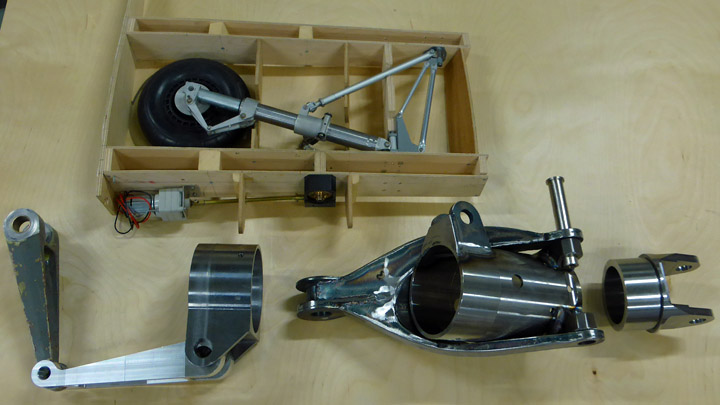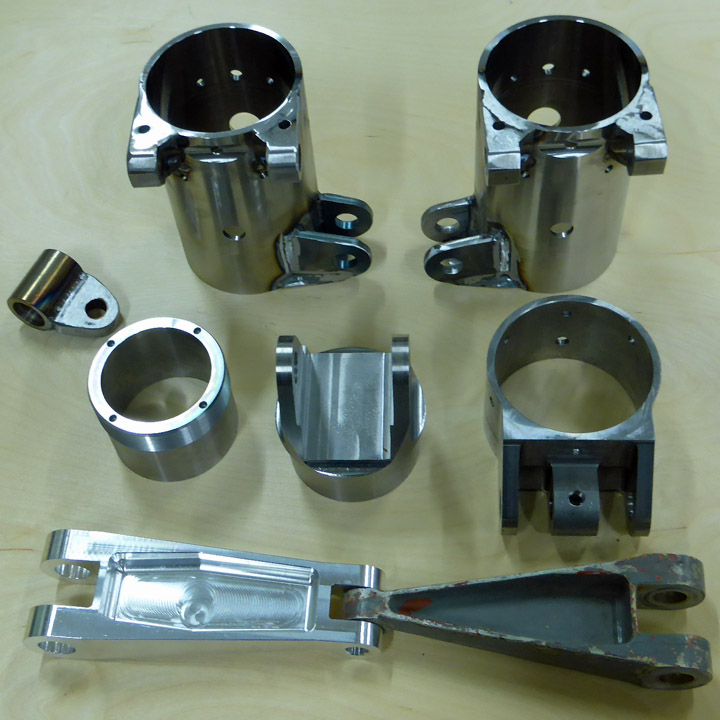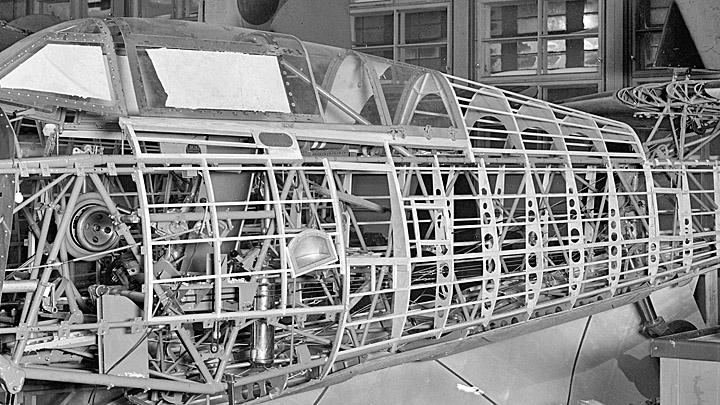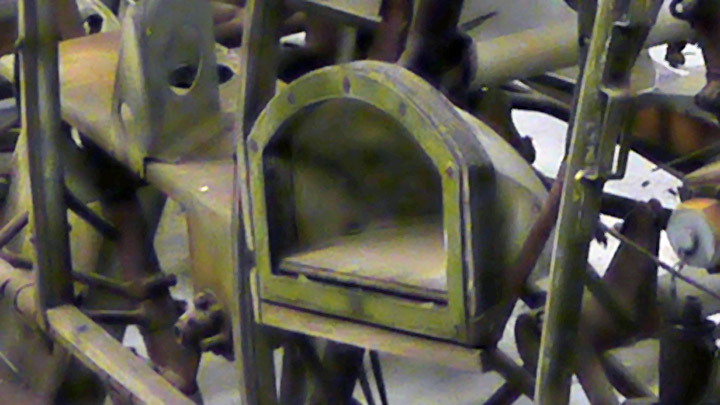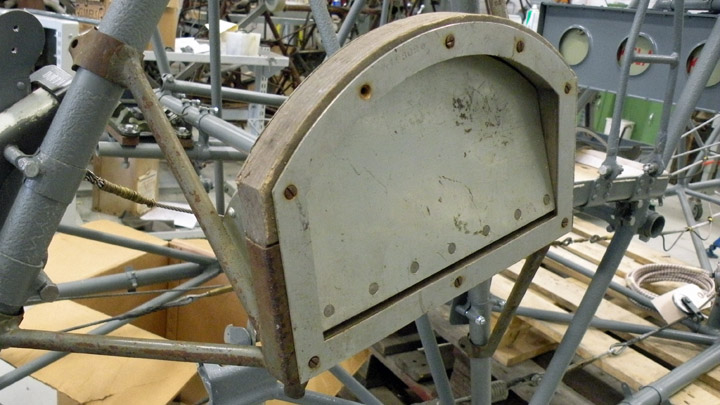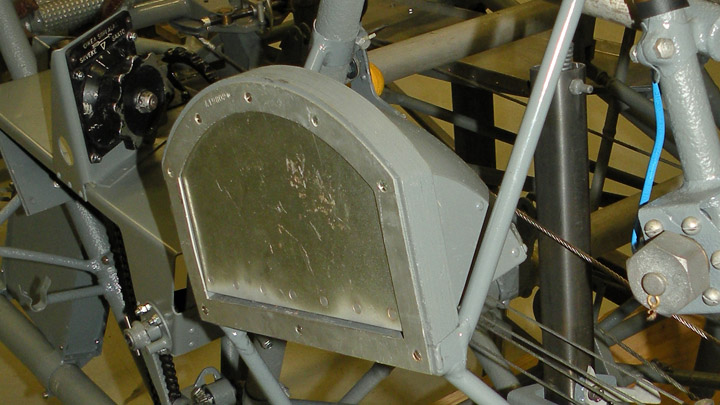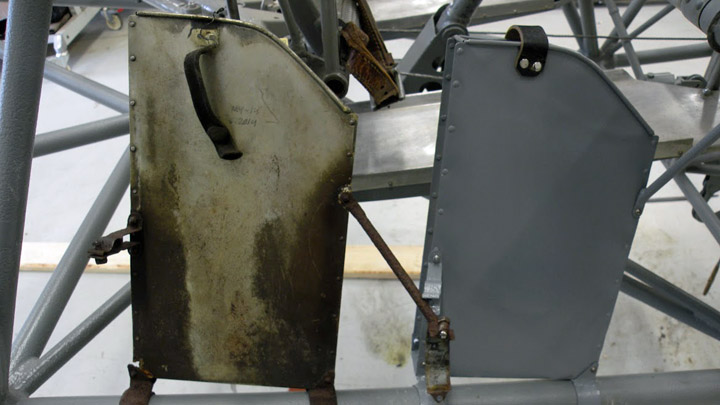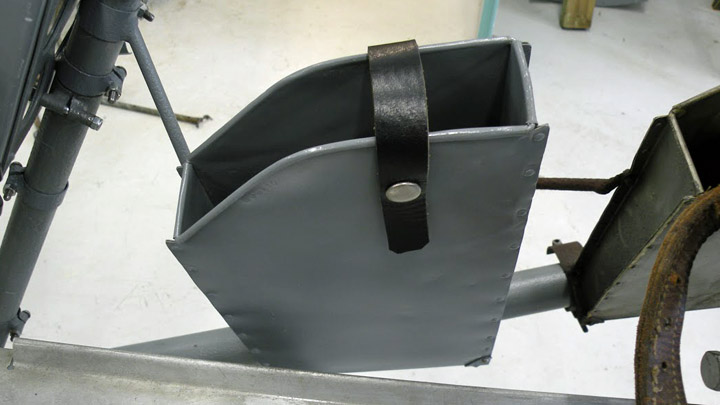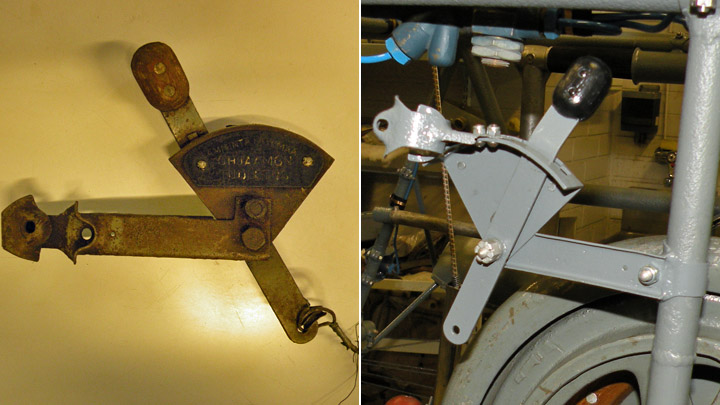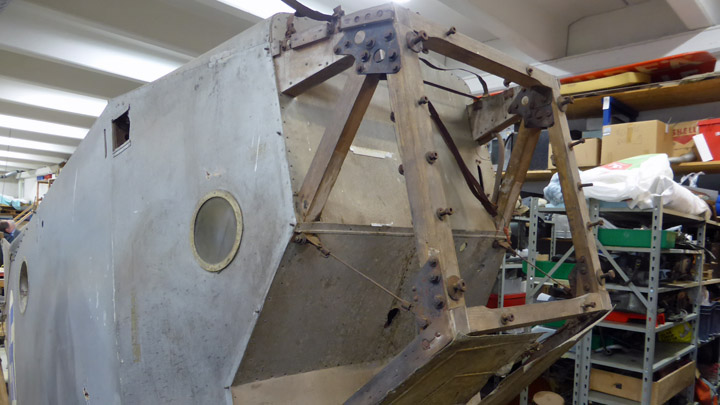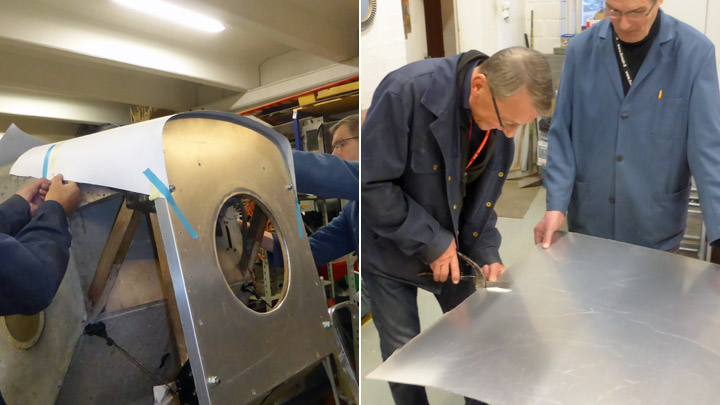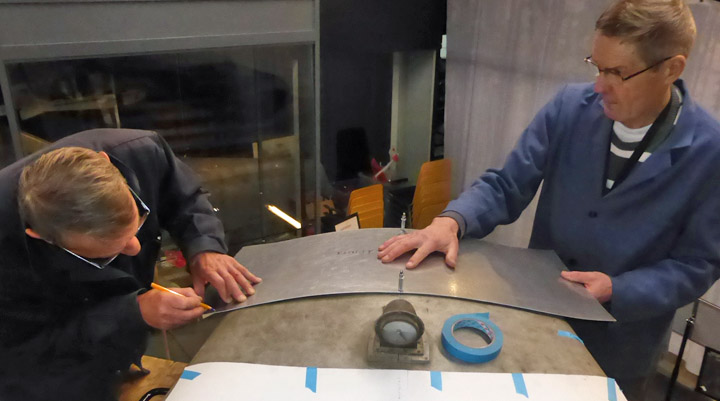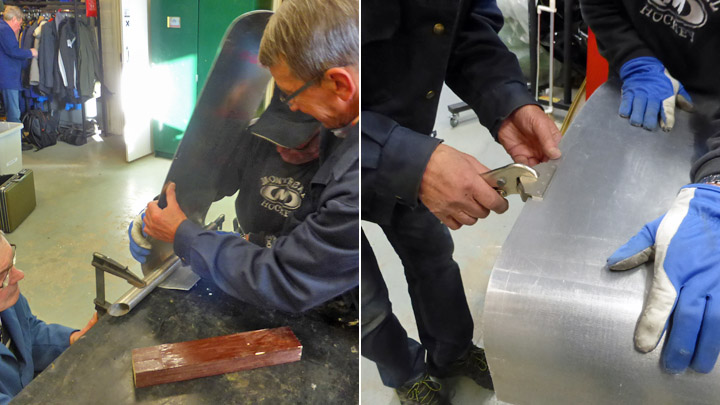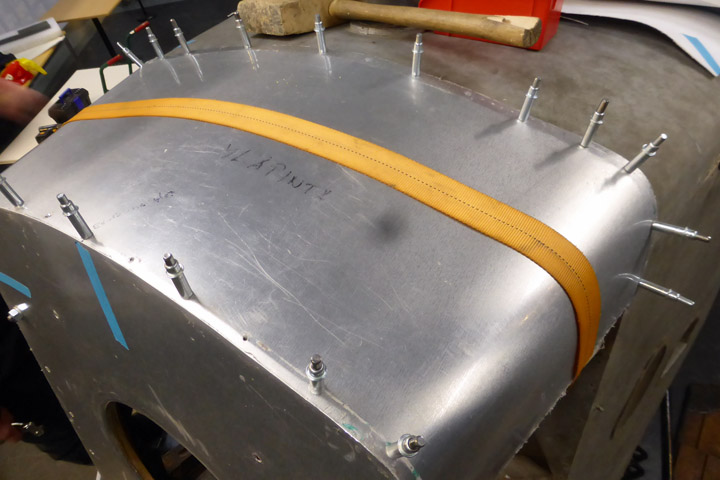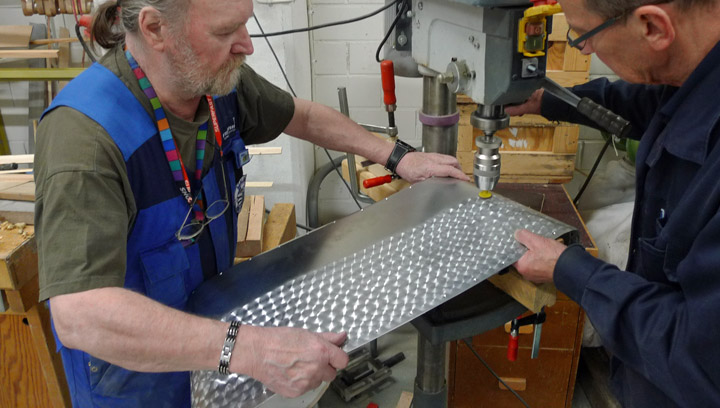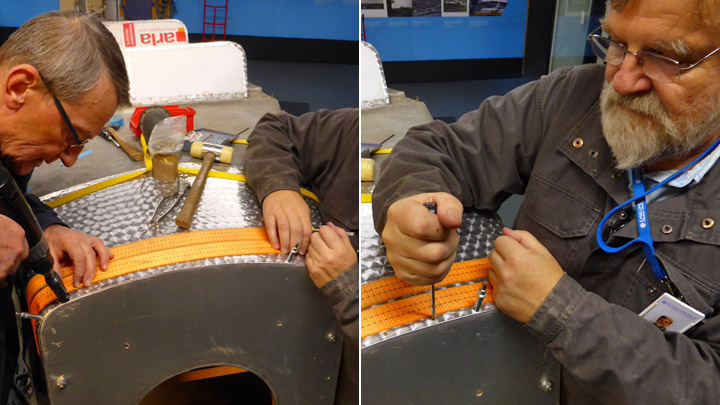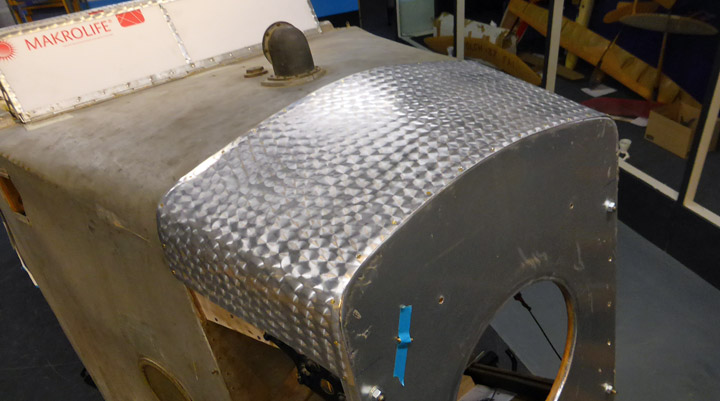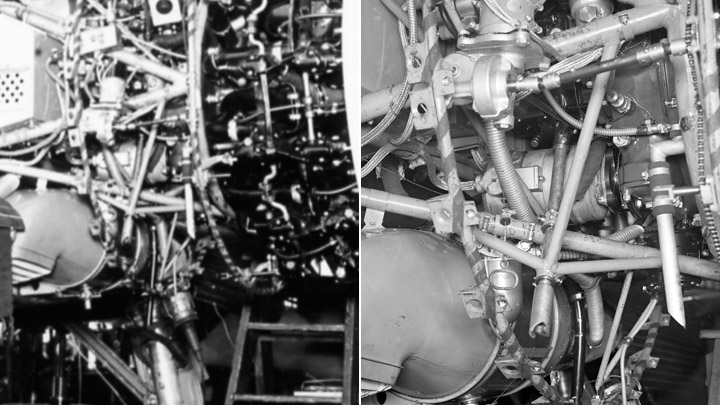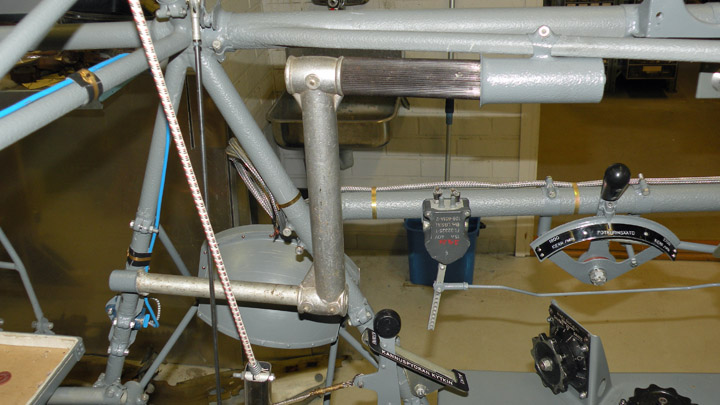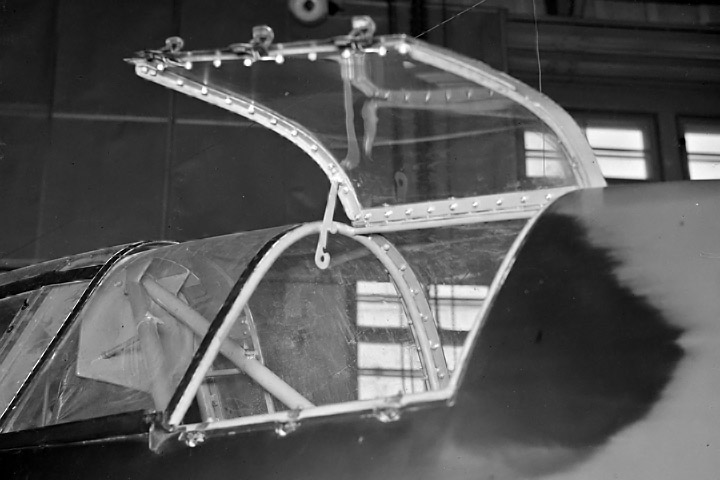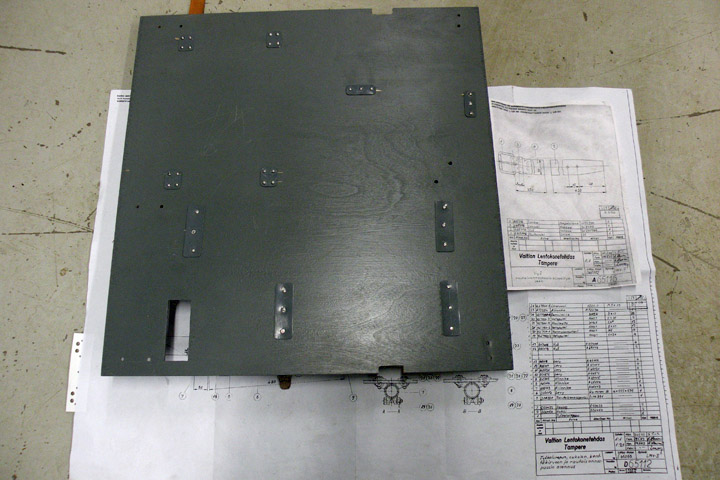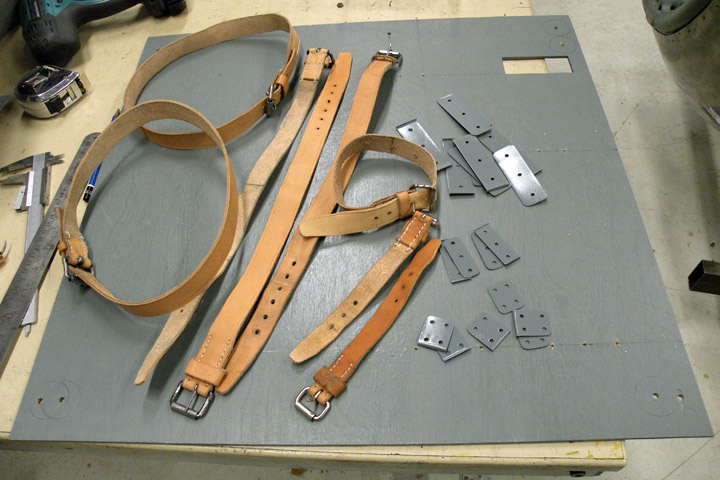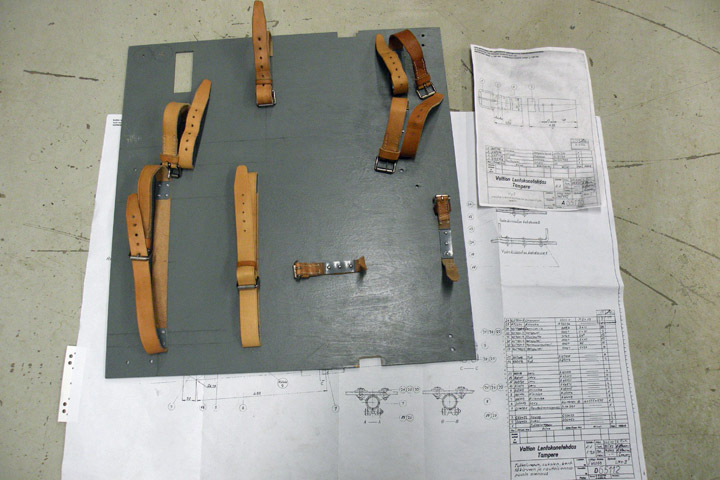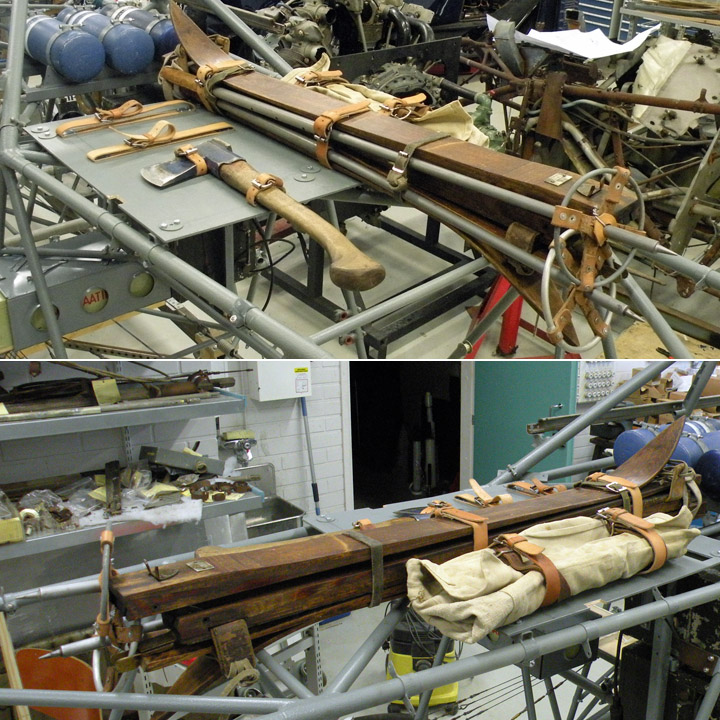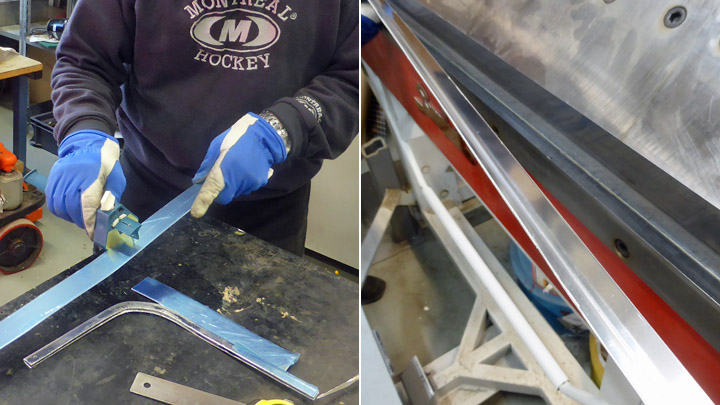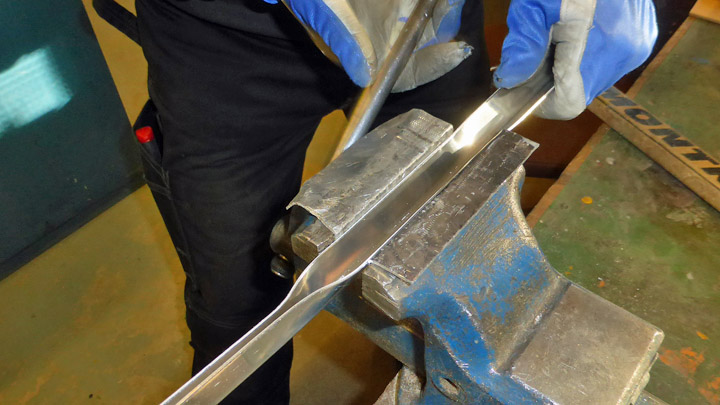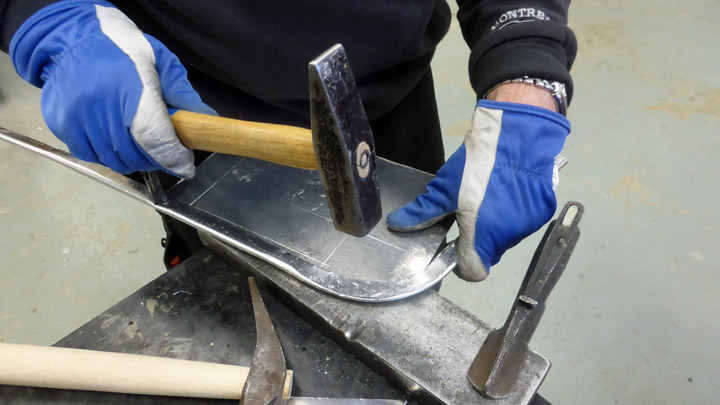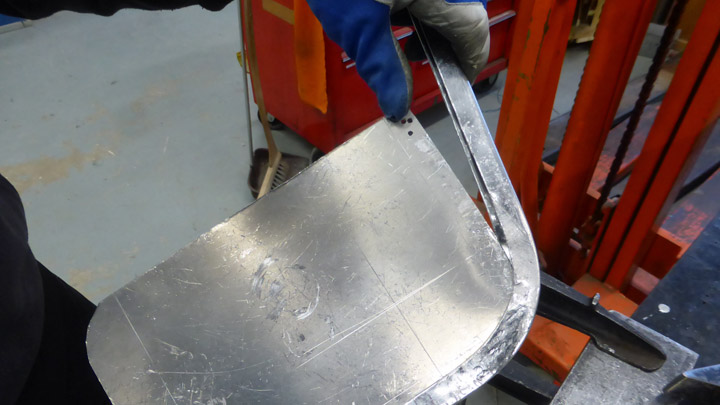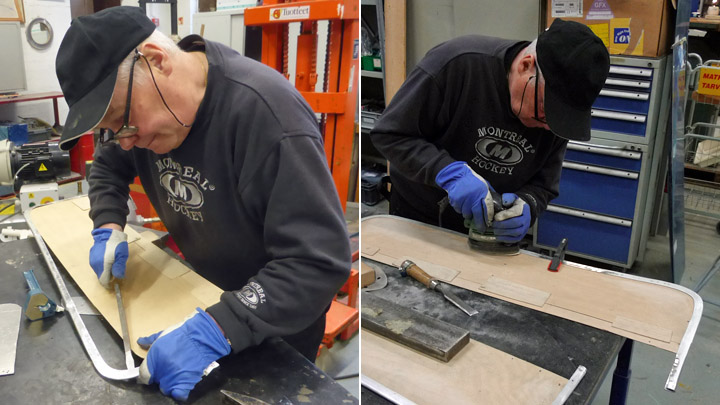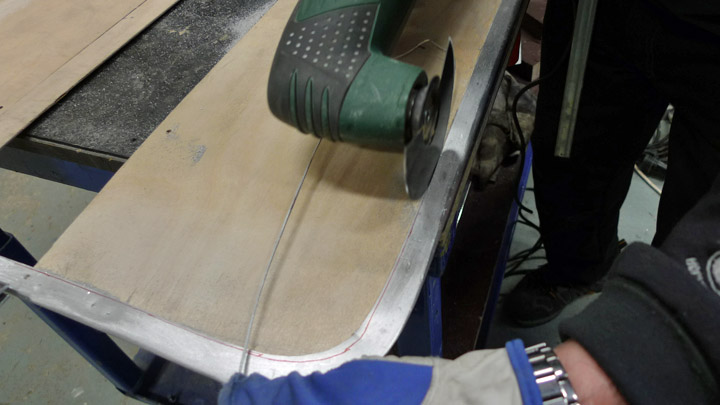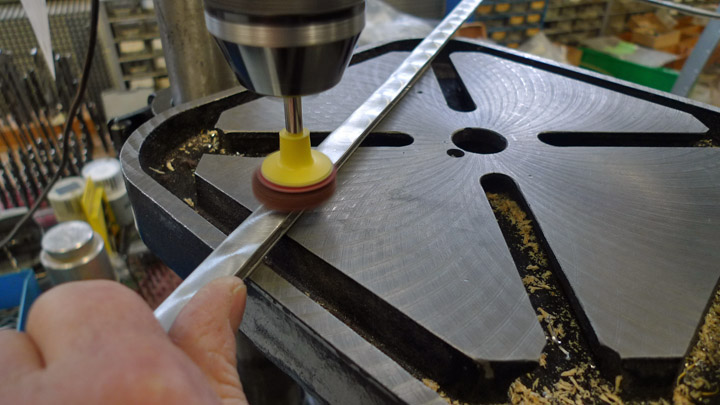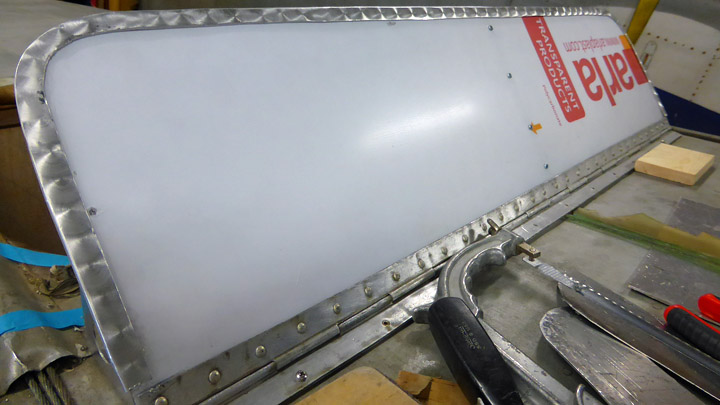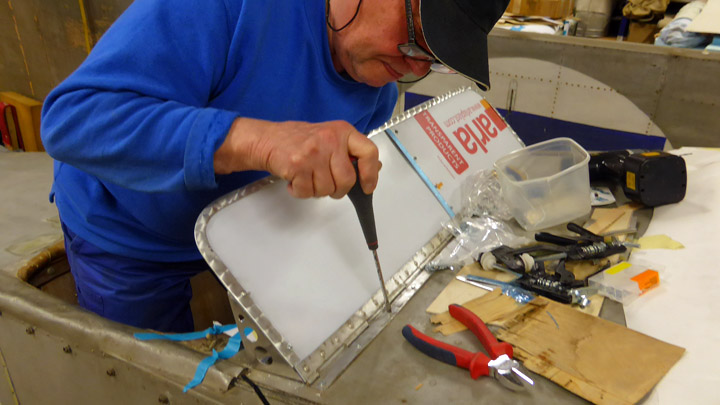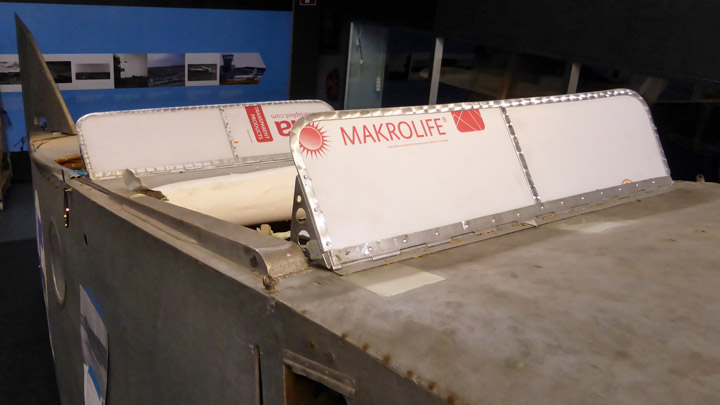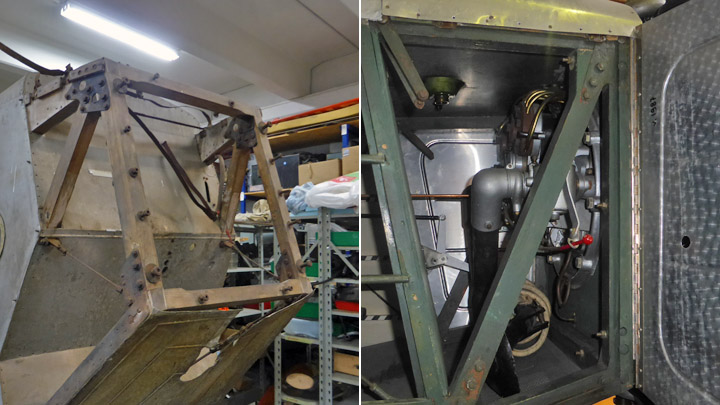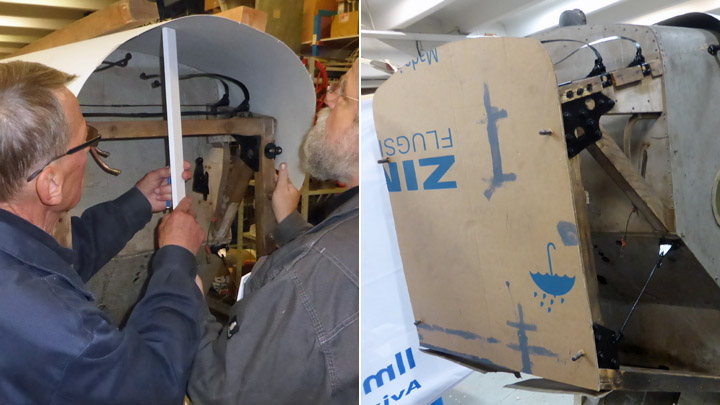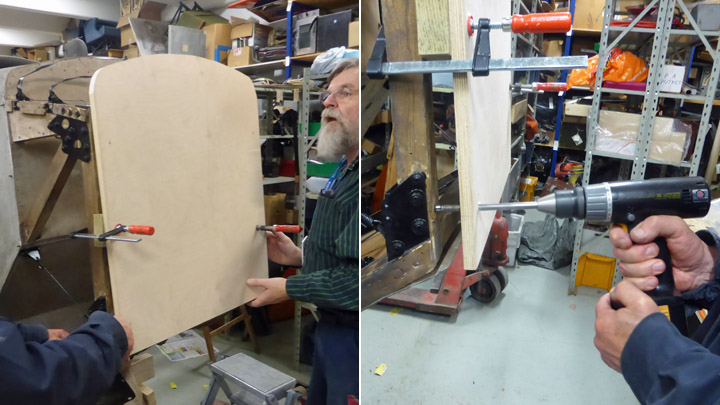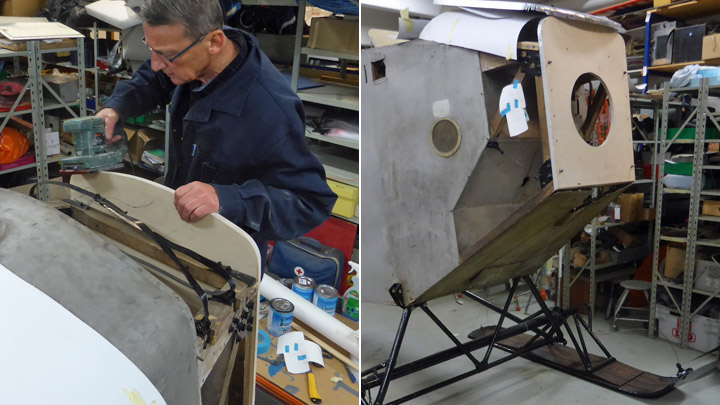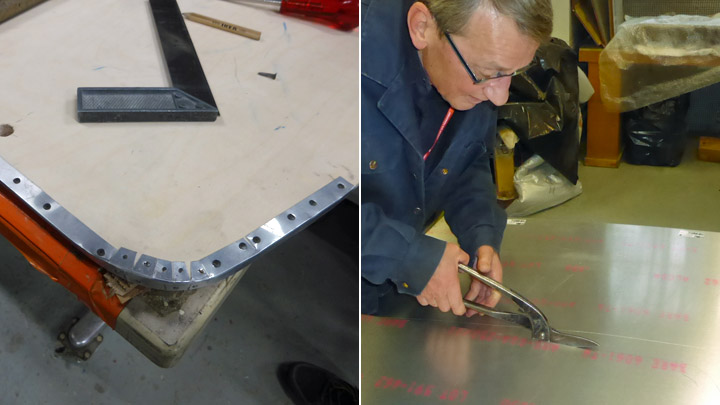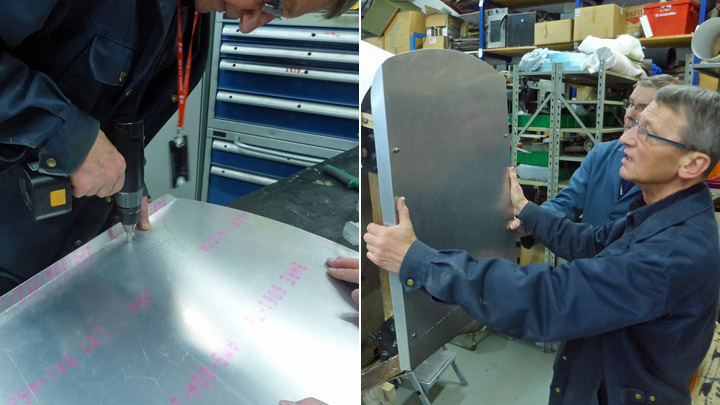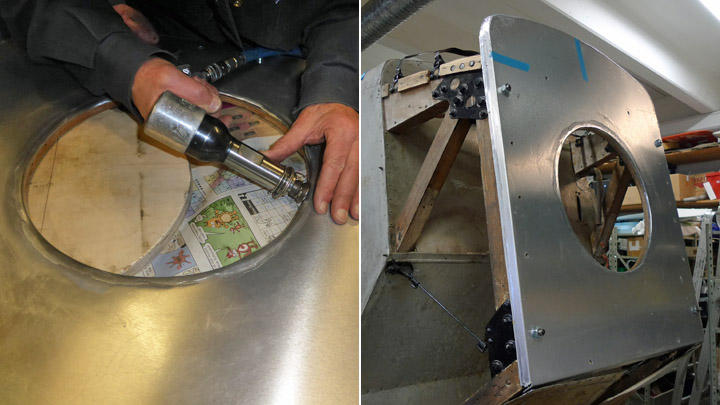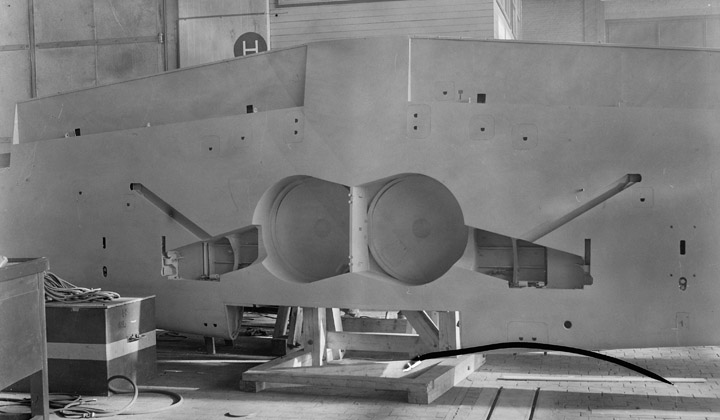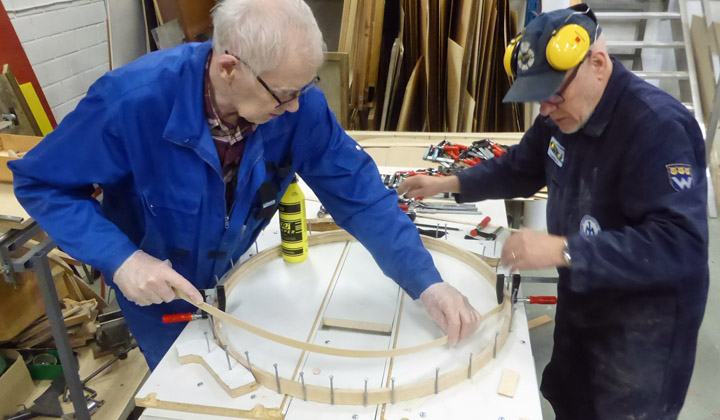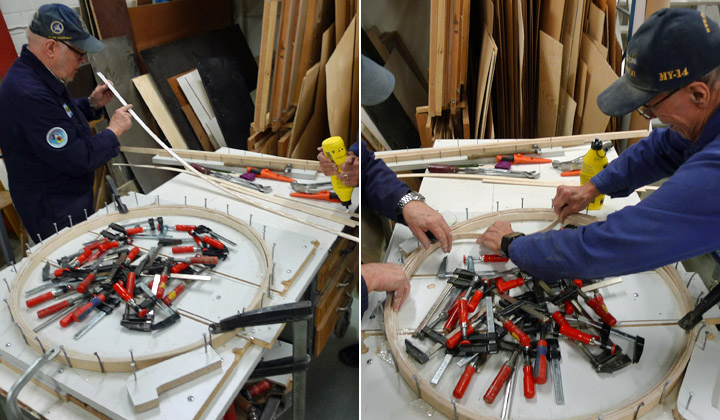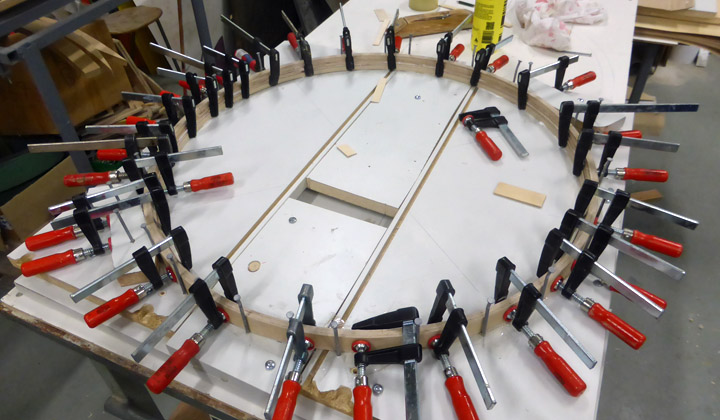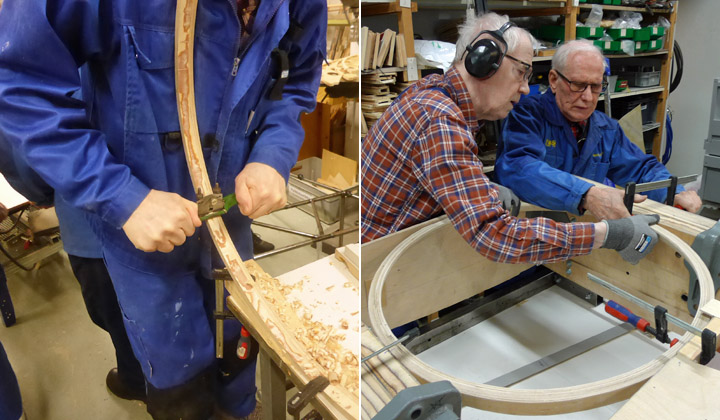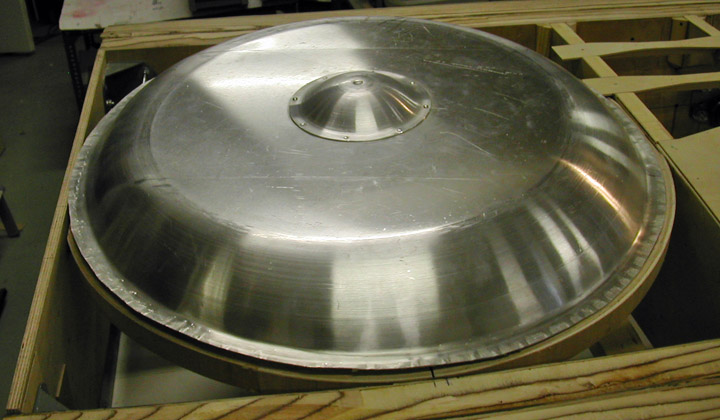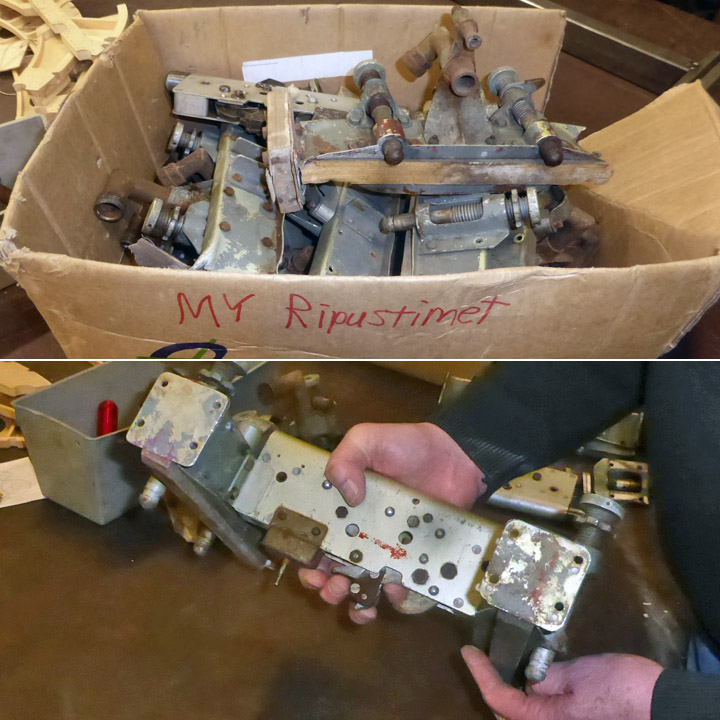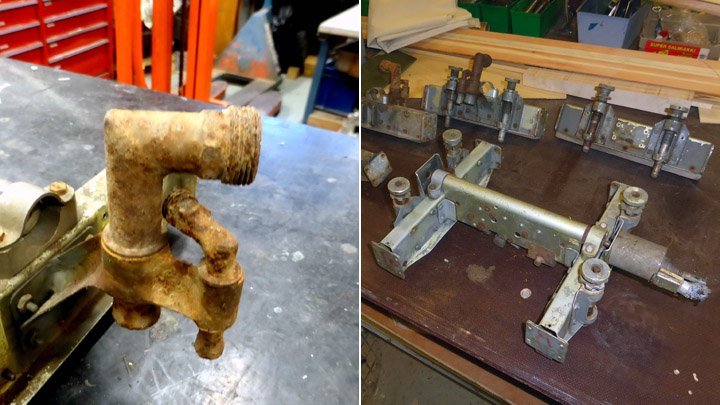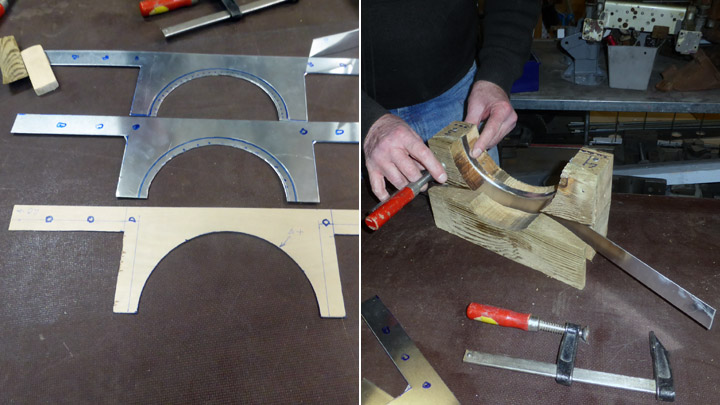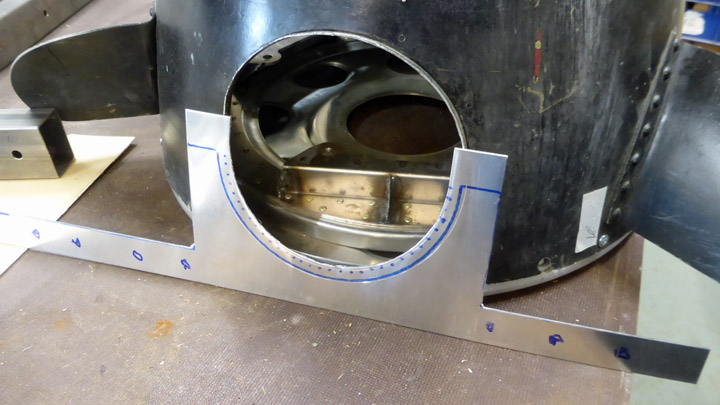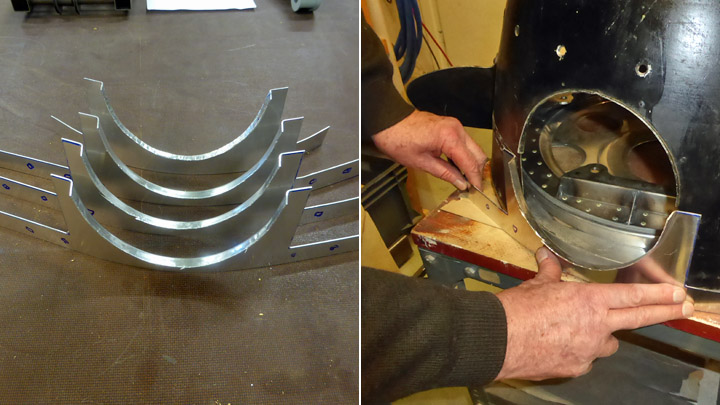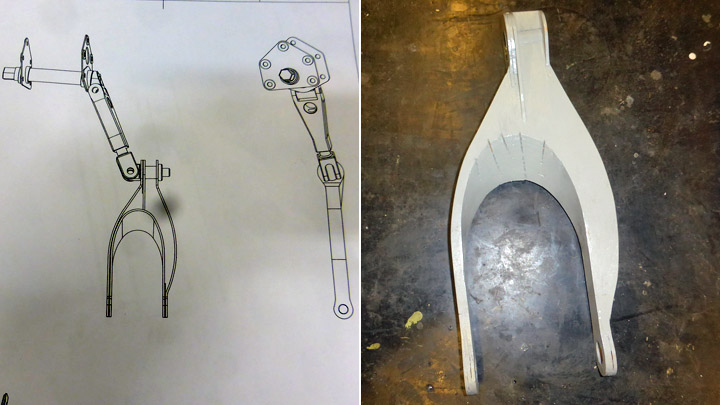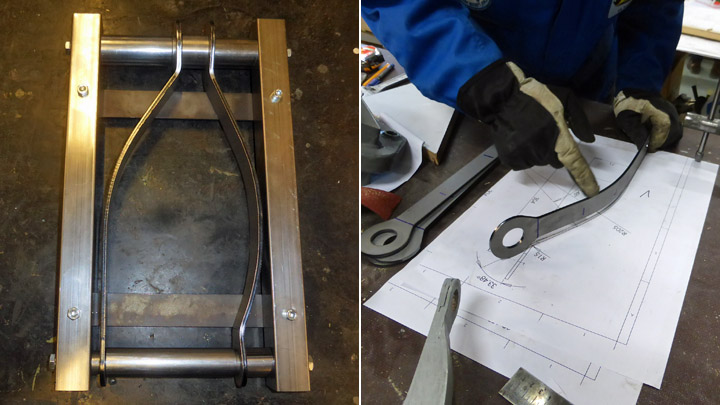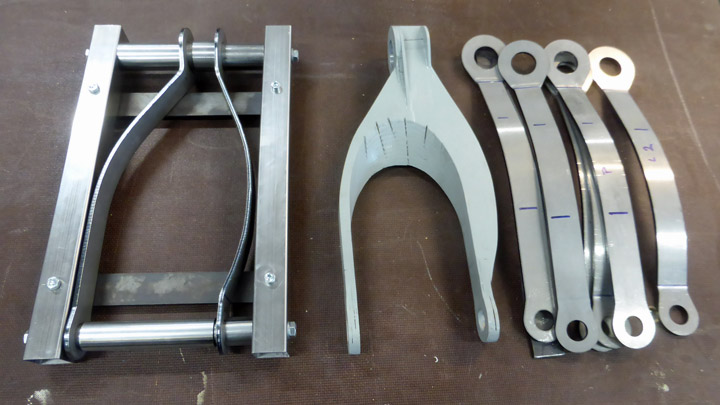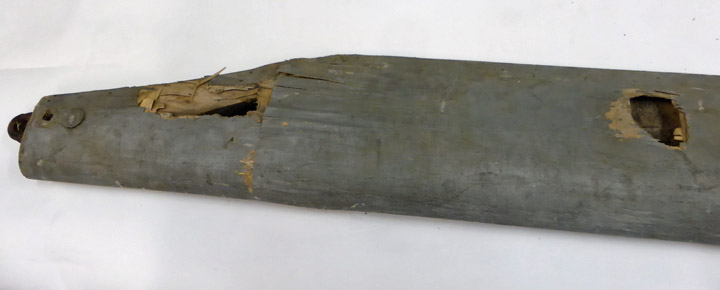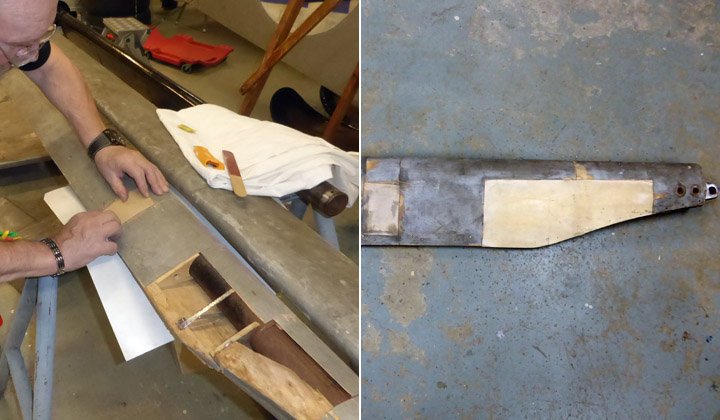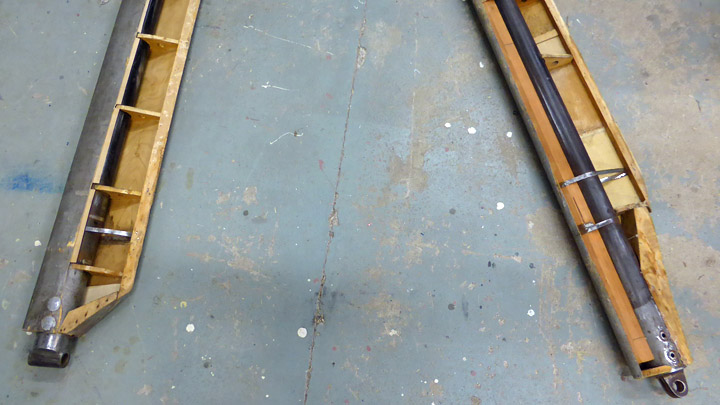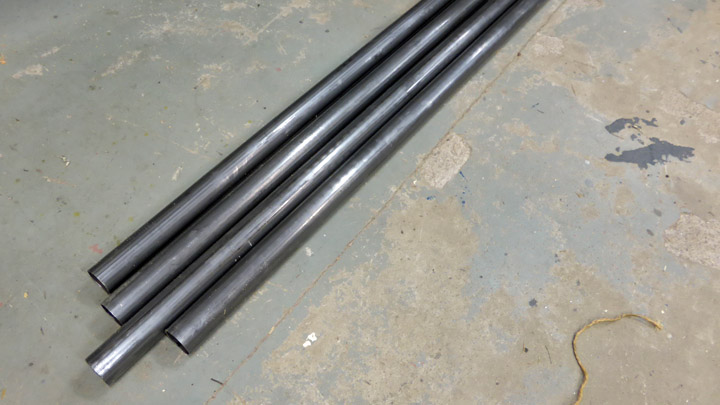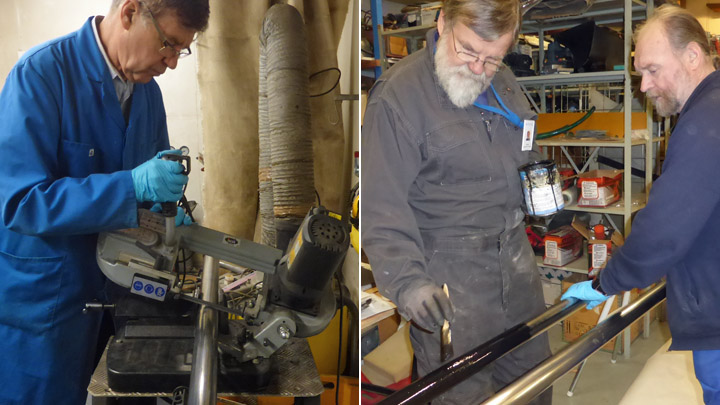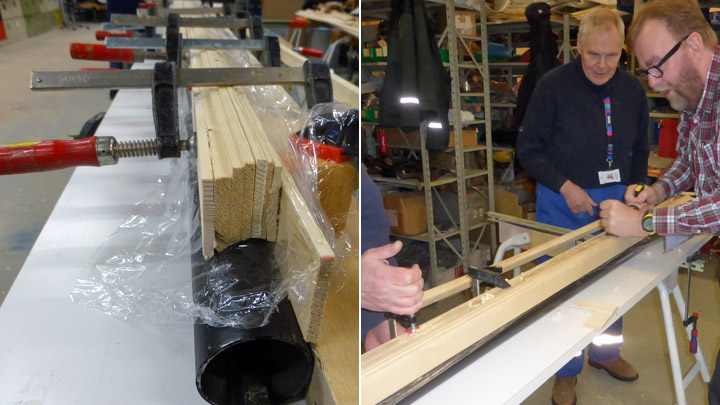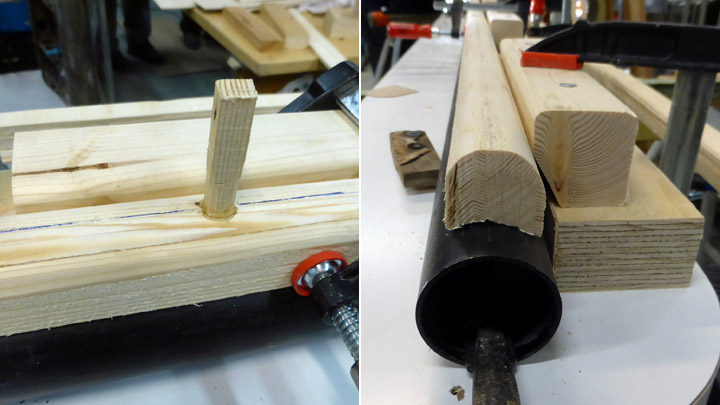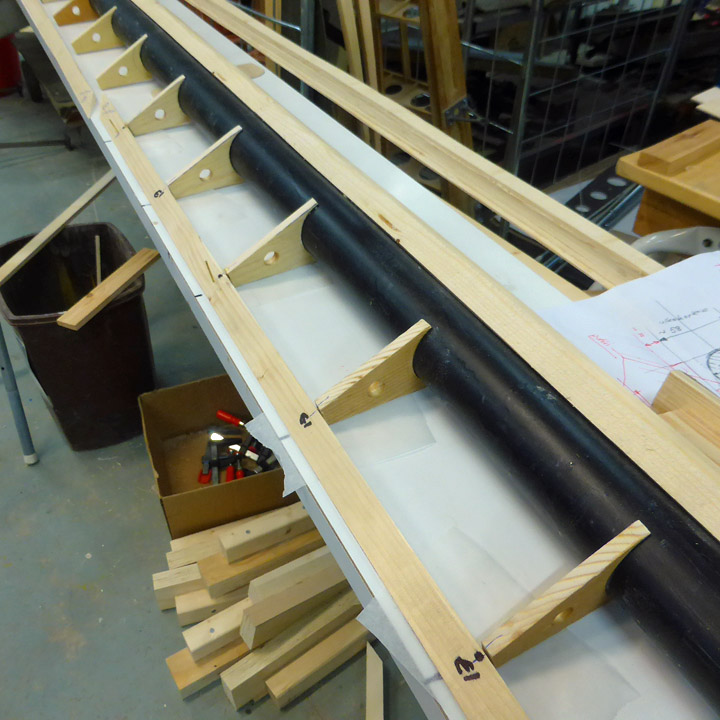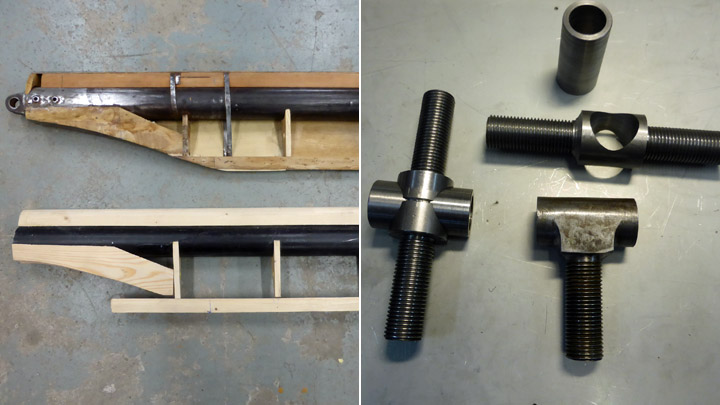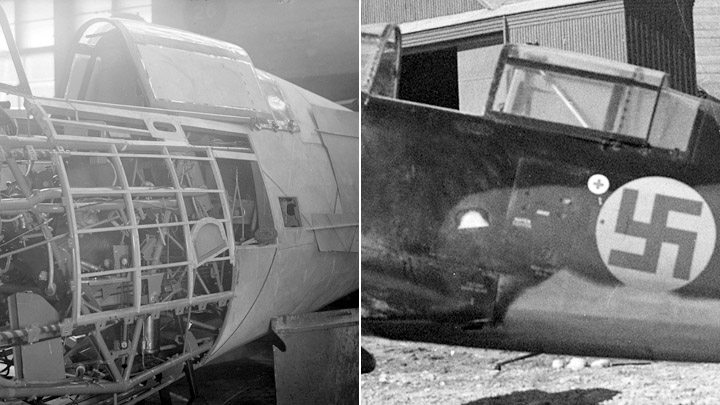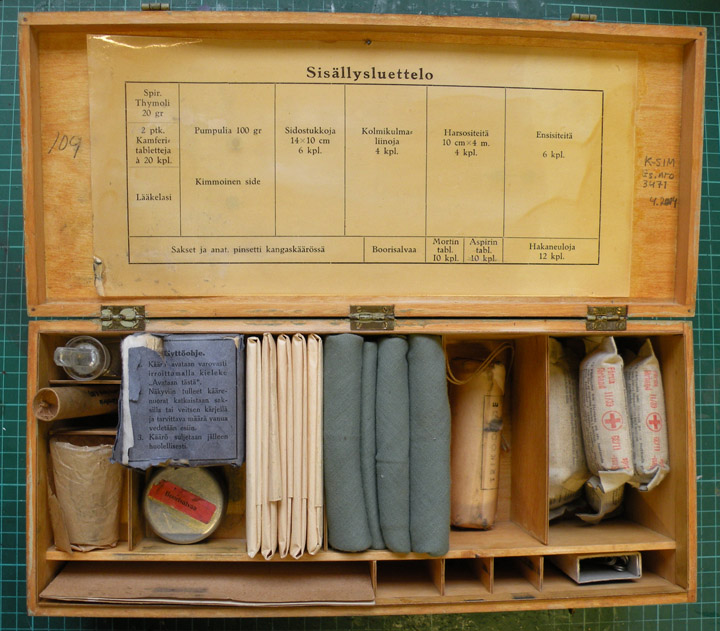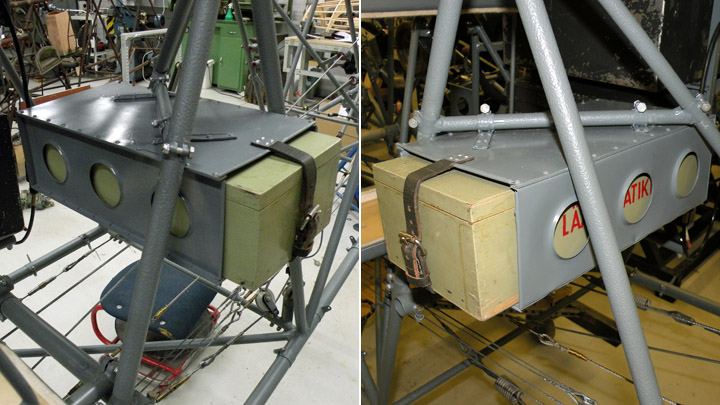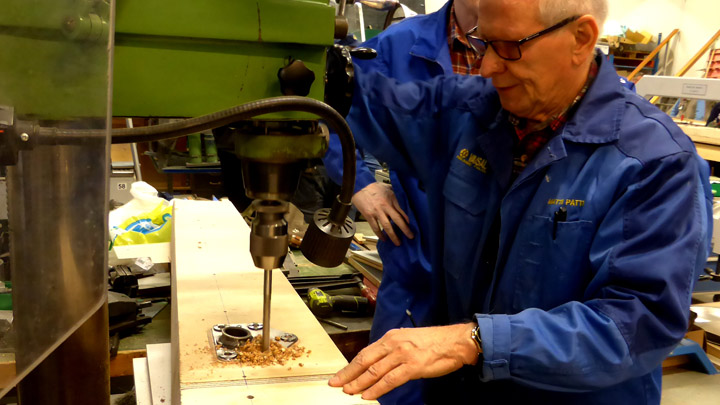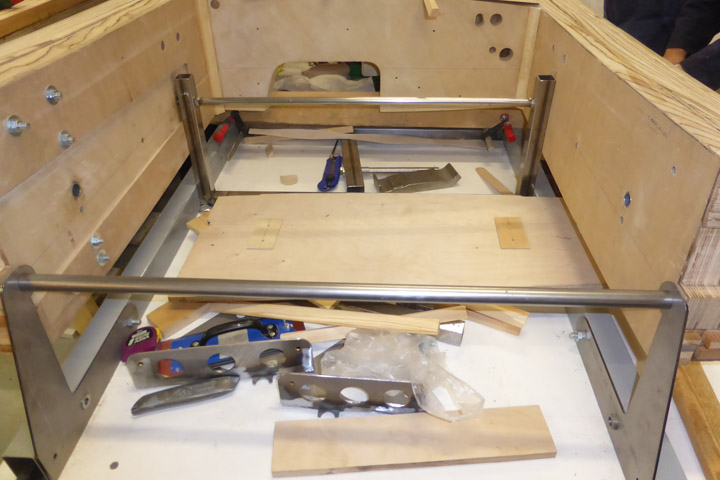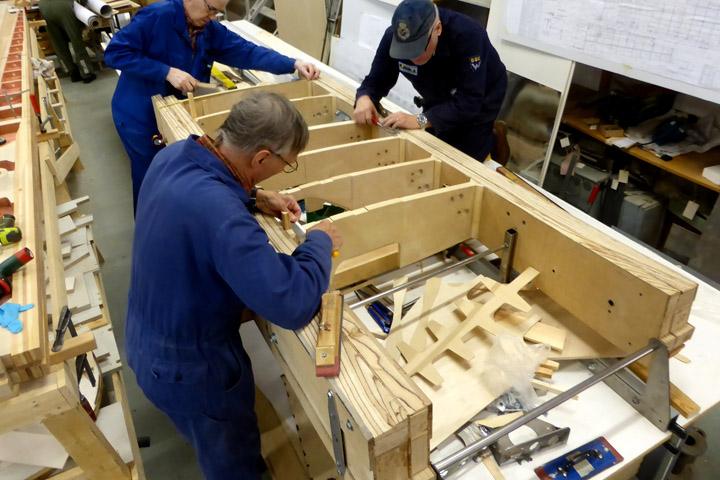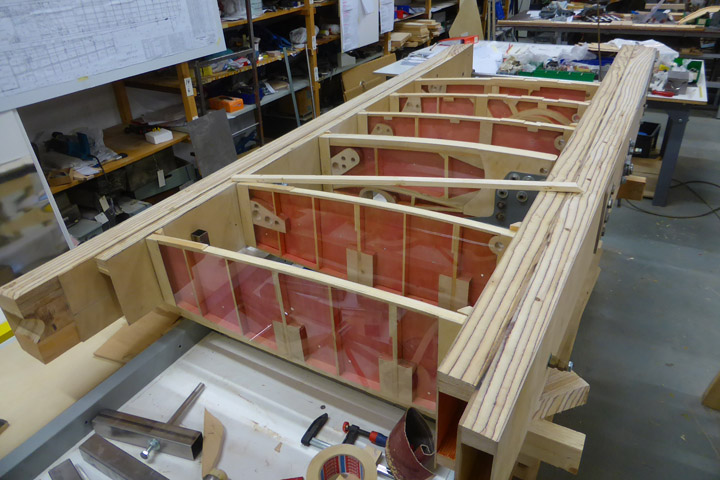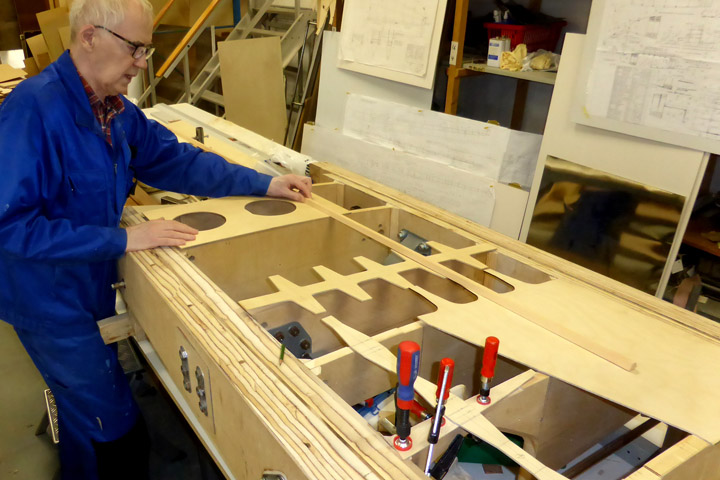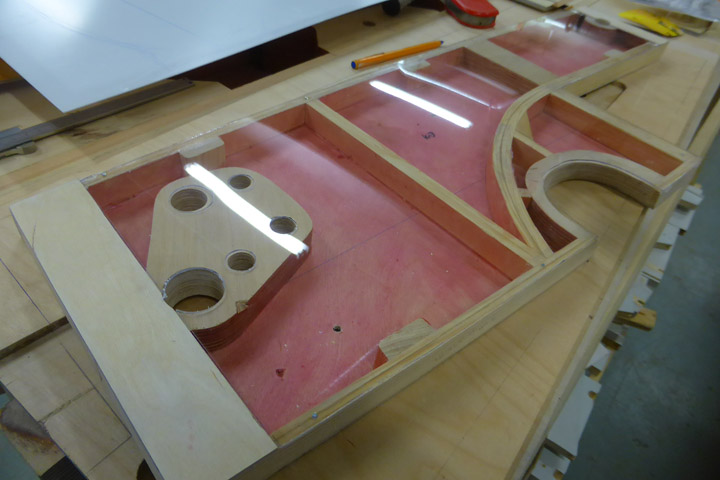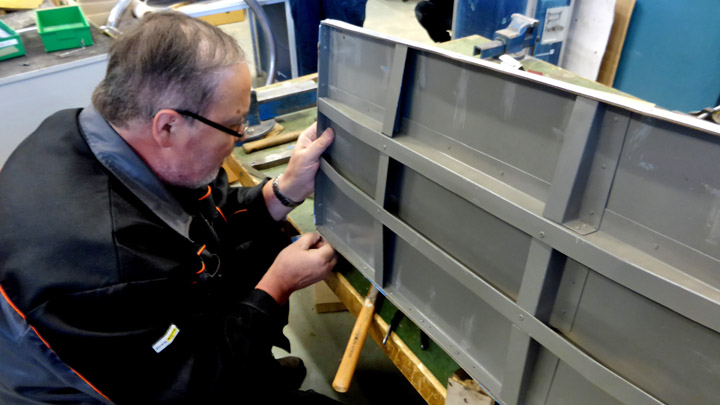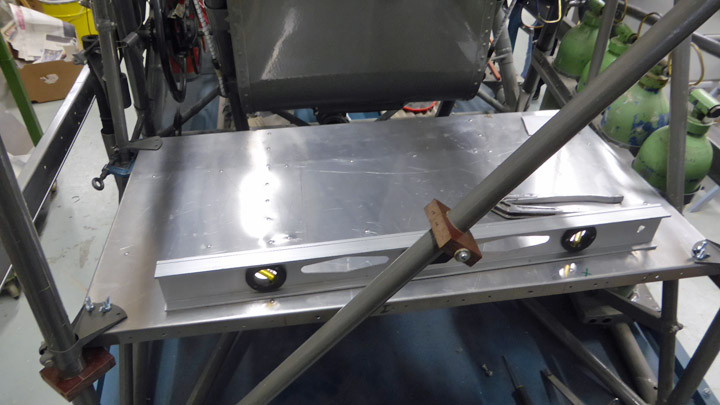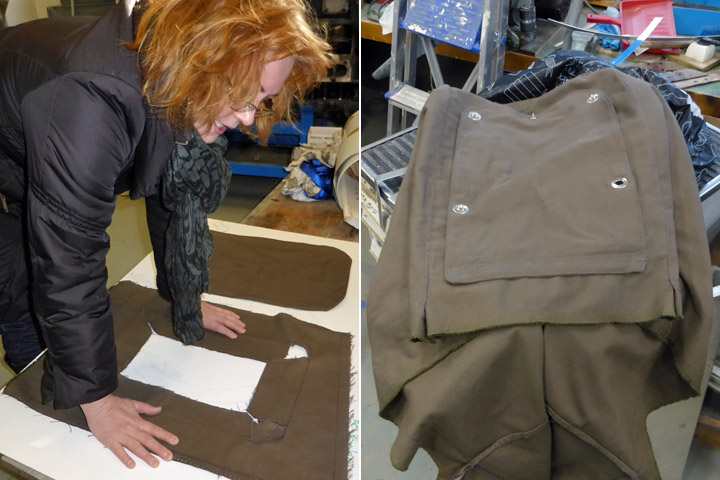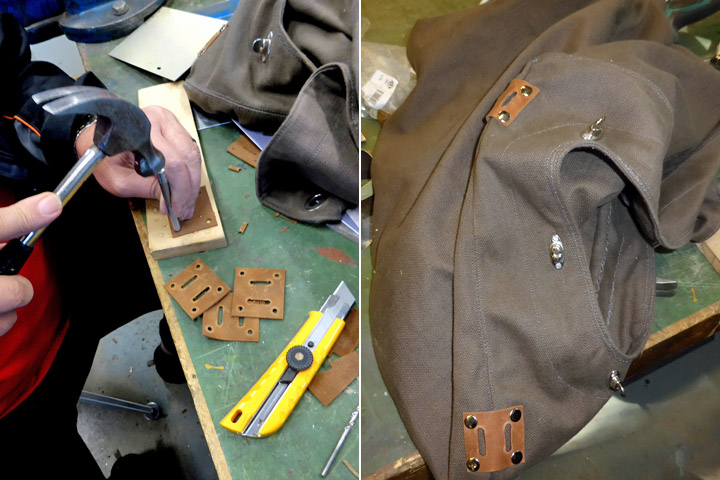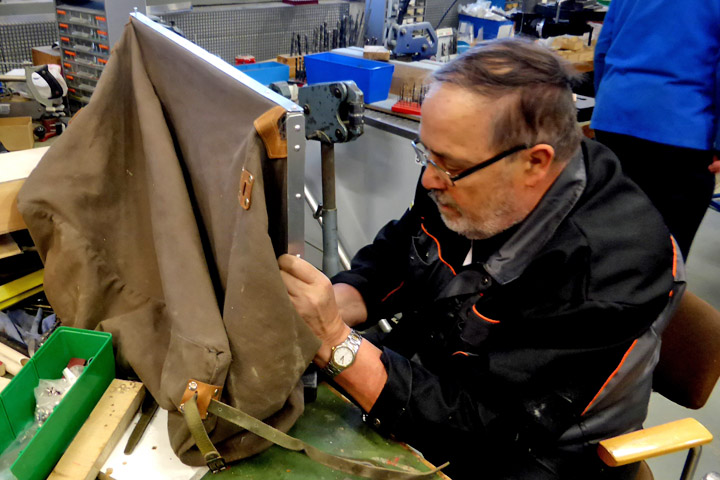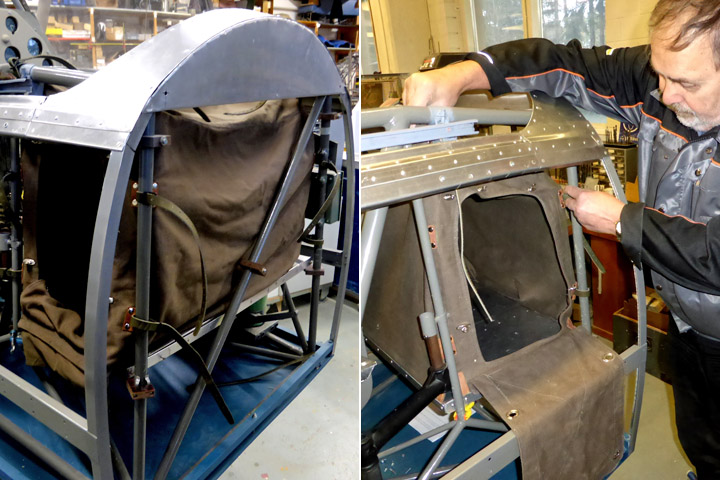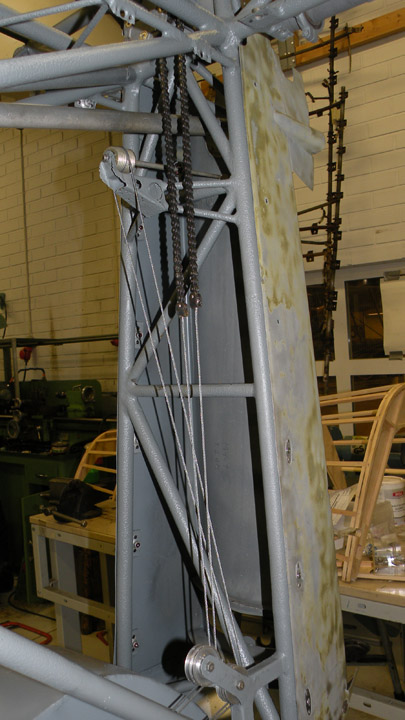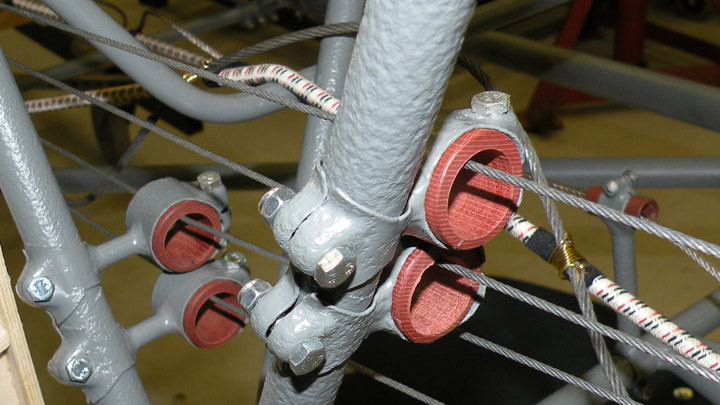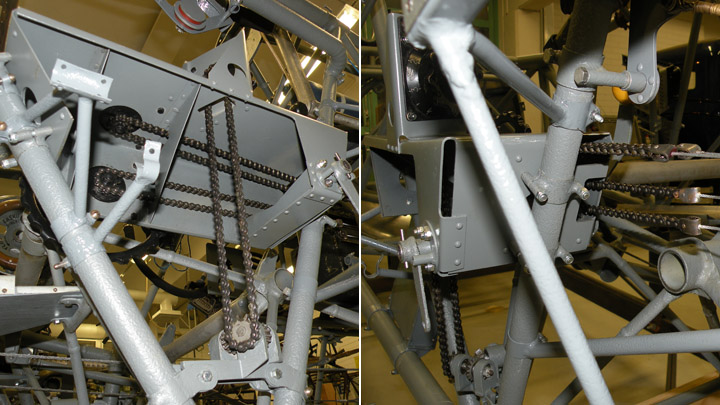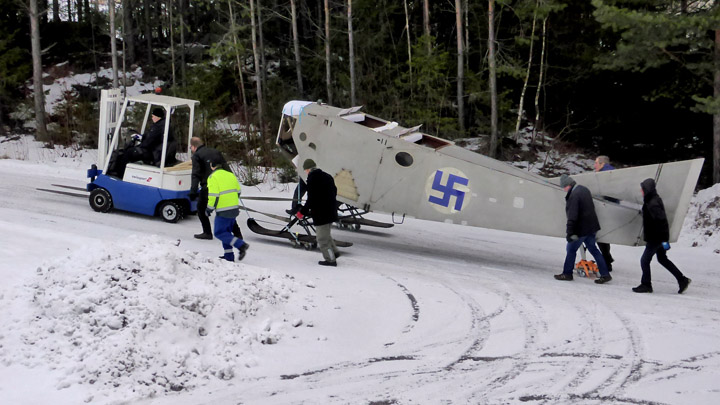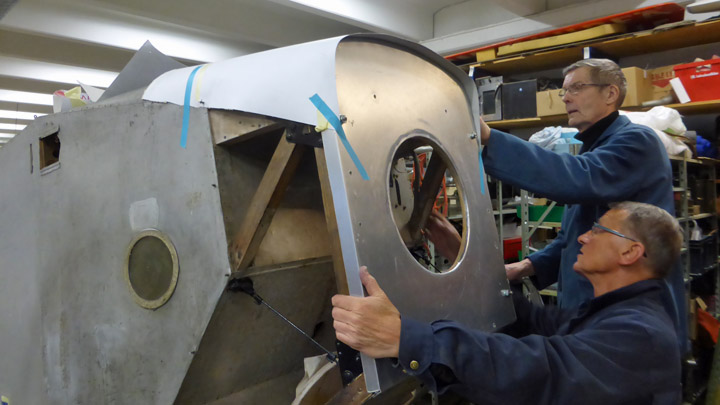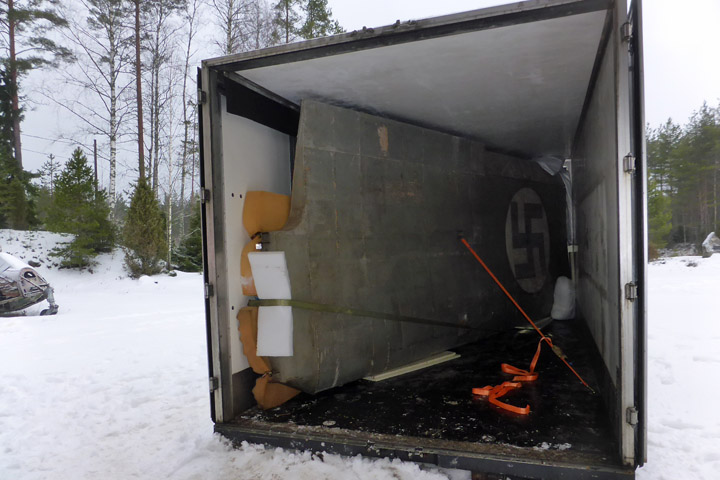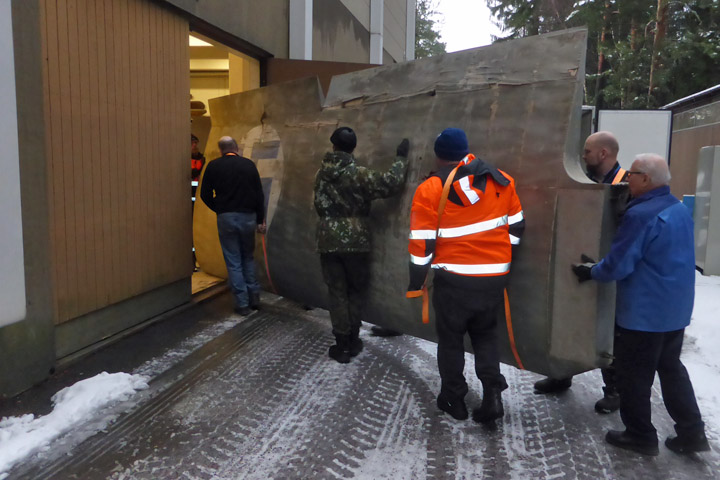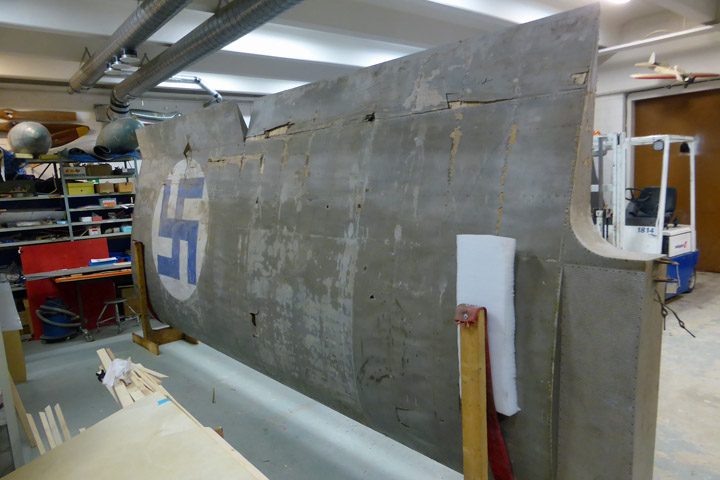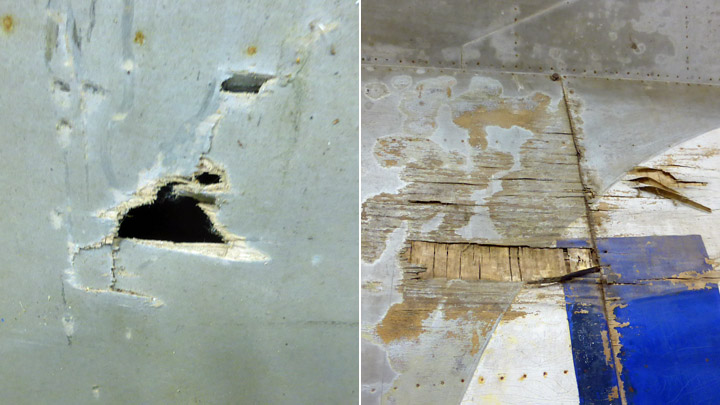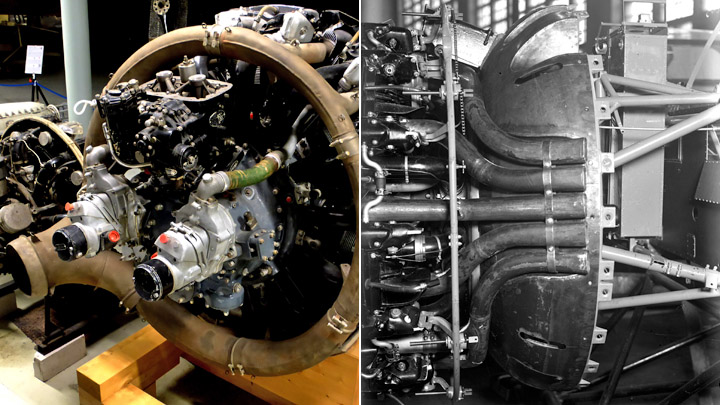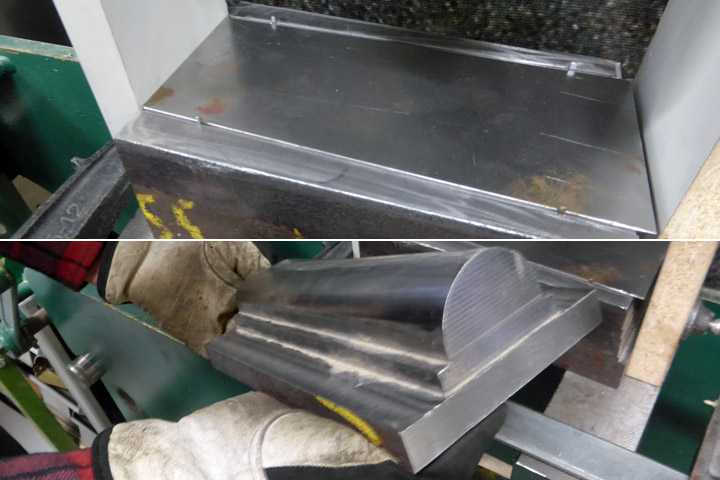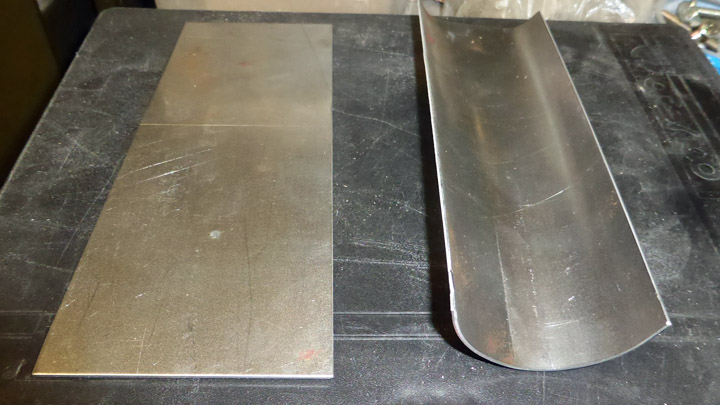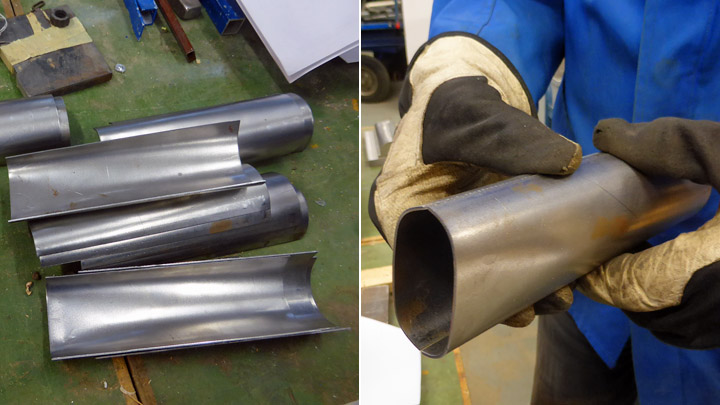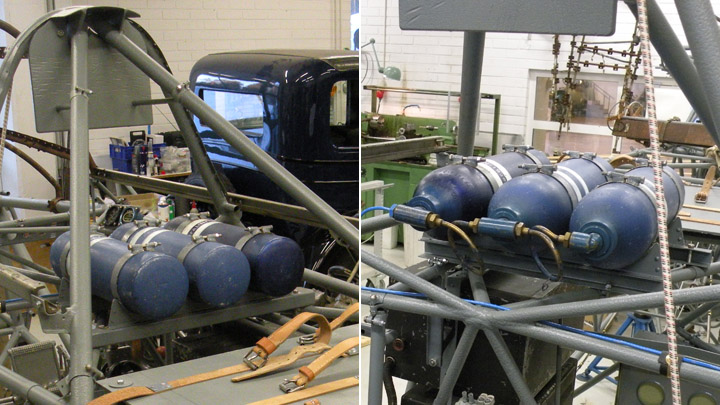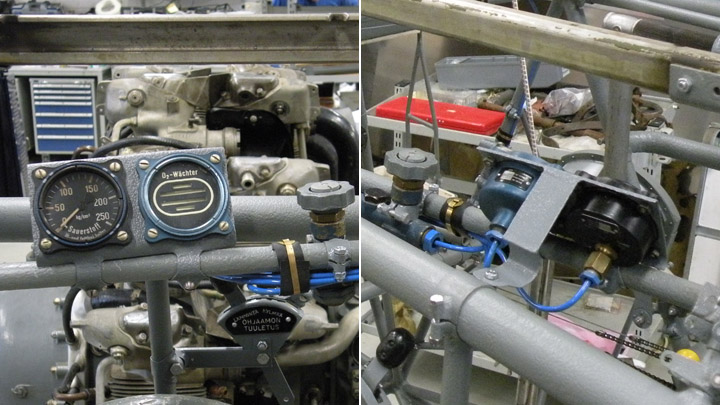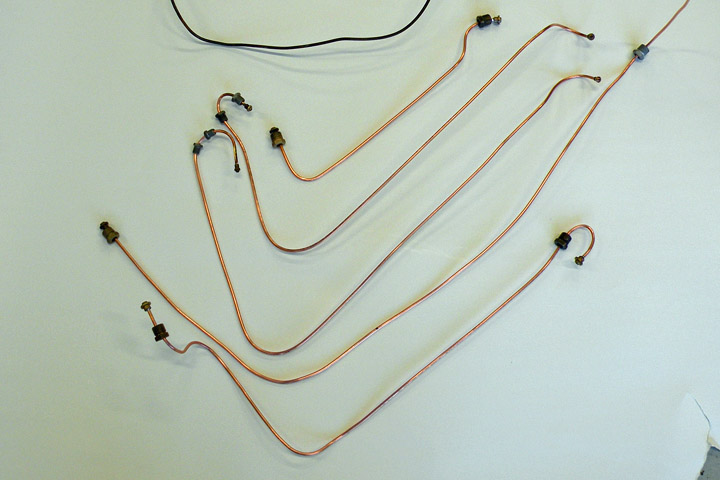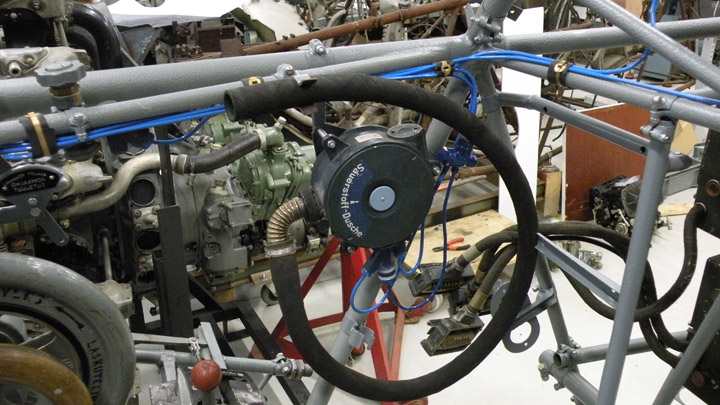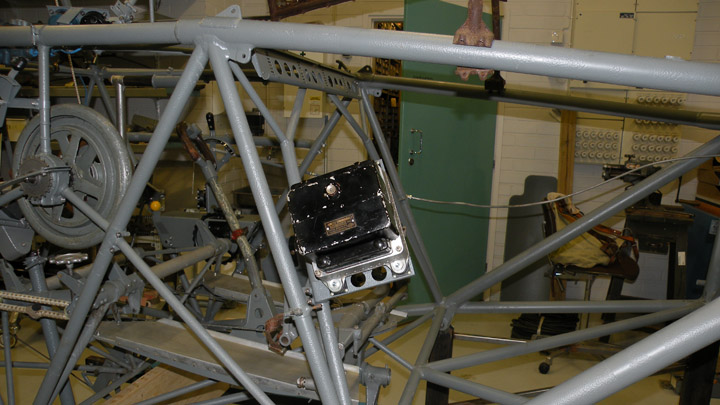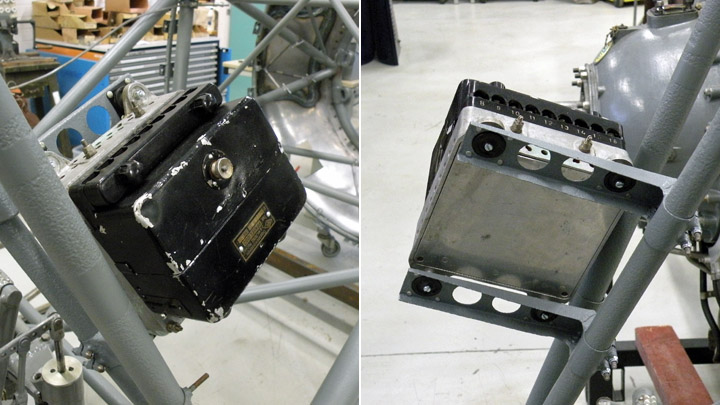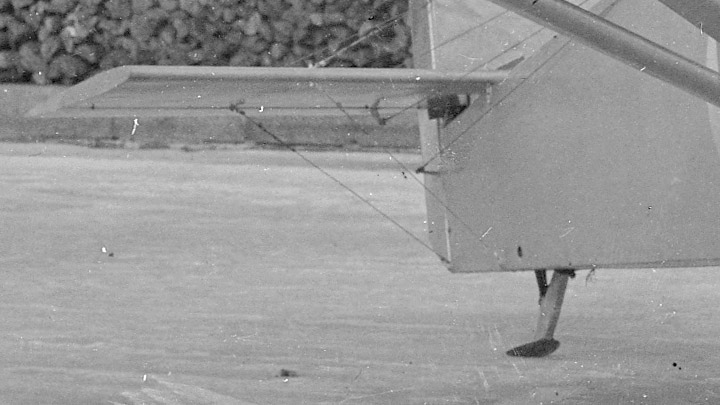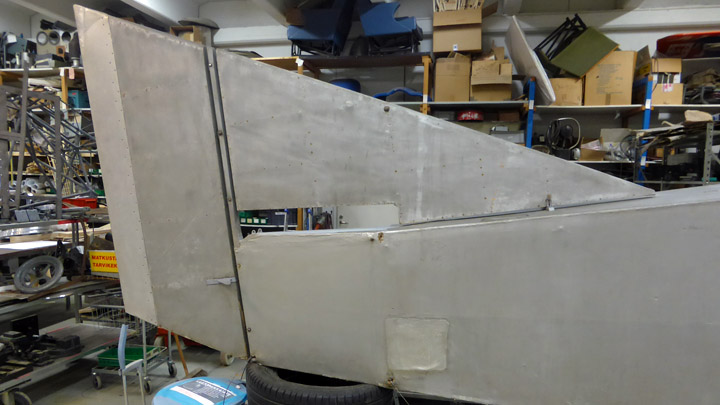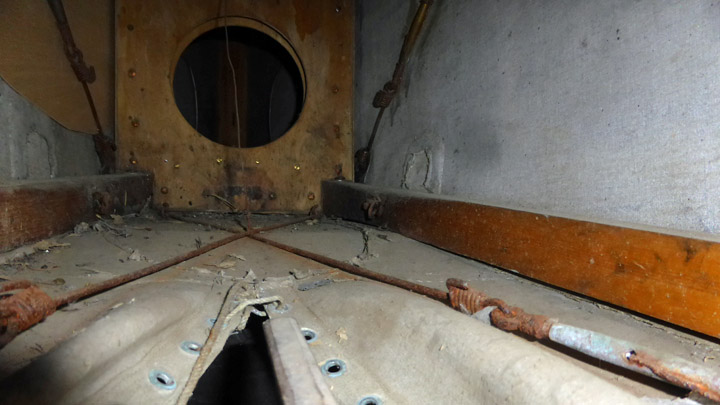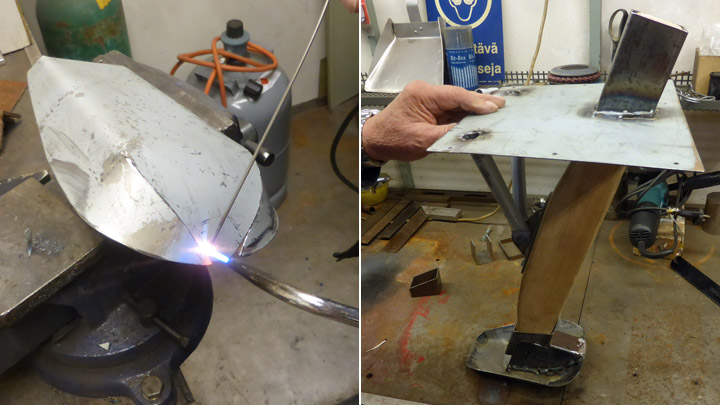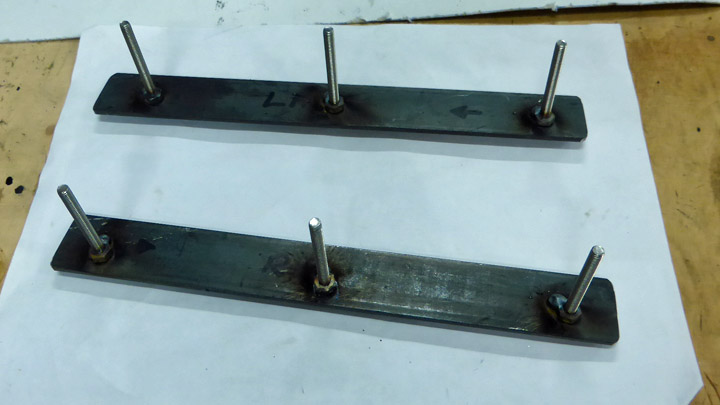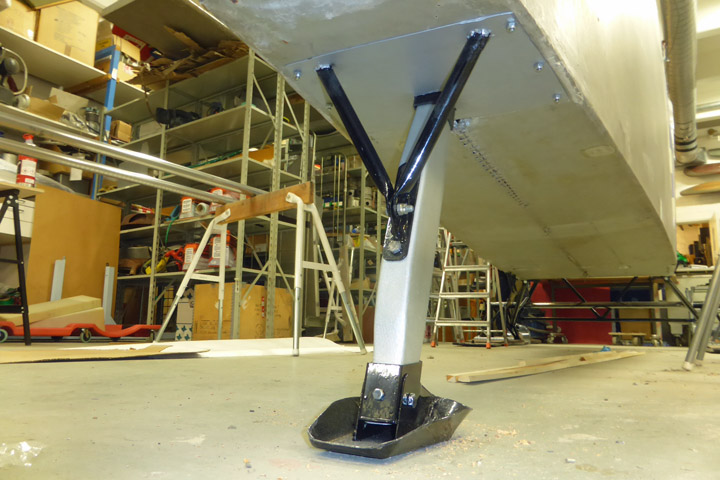About the parts of the Myrsky landing-gear strutsTiistai 6.6.2017 - Member of Tuesday Club Though the test-wing under construction for the VL Myrsky (MY-14) by the Aviation Museum Society’s Tuesday Club is not yet ready for the installation of the main landing-gear parts of the landing-gear assembly have already been made and are ready to be installed. Unfortunately, only some original parts, such as wheels including brake mechanisms and parts for fastening the landing-gear assembly to the wing-spars, have been found. Thus, we need to have a number of the parts for the complicated landing-gear assembly manufactured. Luckily, we have most of the drawings needed for the manufacturing of the landing-gear parts available. Also, the landing-gear of the 1:4 scale Myrsky model made by our Myrsky-project manager Matti Patteri is proving most helpful. Patria Oy has taken the responsibility for manufacturing the oleo-struts. The Tuesday-Club’s Myrsky-project team has taken the responsibility for all other parts of the landing-gear. Thus, in addition to having the main responsibility for the wooden parts, the project team will also work on some metal-parts for the Myrsky.
The topmost object is the landing gear of 1:4 model of Myrsky manufactured by Mr. Matti Patteri. This far, we have already finished the lower and upper forks of the scissor-joint that is a part of landing-gear retraction mechanism at the lower end of the oleo-strut as well as the axle beam components attached to the wheel-hub. Also the lug-tube that will go on to the middle of the oleo-strut and to which the forks of the landing-gear retraction mechanism as well as the rear landing-gear support strut will be attached. The upper fastening fork that goes onto the top end of the oleo strut has already been made.
Matti Patteri has been responsible for the design and guidance for the manufacturing of the metal parts including the laser-cutting as well as for the making of the jigs needed for the welding-work. Welding-work has also been performed at the Vantaa Vocational College Varia. The machining of some of the small metal parts has been done by Elmer Oy. |
|
Avainsanat: aviation history, restoring, old aircraft, VL Myrsky II, MY-14 |
One original wooden part to MY-14Torstai 1.6.2017 - Reino Myllymäki The VL Myrsky II restoration project has three steel-tube fuselage framework (MY-5, MY-9 & MY-14). They have lain on the ground below an open sky at least 20 years. Therefore wooden parts have decayed and steel parts have corroded. The project has got ready for substitute all wooden parts by reproduction ones.
There is boarding step located below the rear side of the canopy in the left side of the fuselage. The boarding step has a small hatch in order to keep the fuselage streamlined when the step is not in use.
The boarding steps of MY-5, MY-9 and MY-14 were all very corroded and the hinges of hatches were stuck. Luckily, one unused original spare part has been found in the storages of the Finnish Air Force Museum. One supporting tube was broken and there is a hole in an aluminium box.
The steel structure, the hatch with hinges and the plywood frame have been taken from the unused spare. The lacking tube was taken from the step of MY-14. It was welded to the steel structure.
The aluminum box was taken from the step of the MY-5. The metallic parts were blasted by glass balls and painted. The dented aluminium parts of the box and the hatch were corrected. The original screws of the plywood frame and box were substituted by equivalent new screws. It seems that MY-14 will have at least one original wooden part: the plywood frame of the boarding step. Historical photo: The Finnish Aviation Museum. MY-9 photo: Reino Myllymäki. Other photos: The Finnish Air Force Museum. |
|
Avainsanat: aviation history, restoring, old aircraft, VL Myrsky II, MY-14 |
MY-14 got more equipmentKeskiviikko 24.5.2017 - Reino Myllymäki There is a metallic map box on the left hand side of the cockipit of the VL Myrsky II. Luckily we have an original part. The proper box is in a good condition but a little crooked and the leather strap was in poor condition.
The map box was blasted by glass balls, straightened, primed by Isotrol lacquer and painted to colour tone Ral 7045 (gray). The leather strap was renewed but the popper is original. The strap was riveted to the box. The box was fixed by renews bolts and screws to the cockpit.
There is a fresh air lever on the right side of the cockpit. The original was in a very poor condition. Luckily a quite complete original part was found from the storages of the Finnish Air Force Museum. Only the another fastening band was lacking.
The fresh air lever was blasted and painted. The help texts were renewed, too. The lacking fastening band was substituted by a repaired original part. The wire of the lever will be installed later. |
|
Avainsanat: aviation history, restoring, old aircraft, VL Myrsky II, MY-14 |
The engine-mounting cover-plate for the Kurki in placeMaanantai 22.5.2017 - Member of Tuesday Club When the fuselage of the I.V.L. K.1 Kurki was brought from the Päijät-Tavastia Avaition Museum to the Aviation Museum Society (Finland) Tuesday-Club for renovation it was a rather sorry sight. The tail was broken, the covering of the fuselage had holes and other damage, only bits and pieces of the windscreens remained, the metal parts were badly corroded and the engine mounting lacked both cover- and endplates.
During the year this fuselage has been worked on in the restauration workshop at the Finnish Aviation Museum and this work will soon be finished. In the Tuesday-Club the last months have been spent making the missing parts of the engine-mounting. The first part to be finished was the engine mounting plate, the work on which has already bene covered in an earlier blog-entry. Now we have finished the upper cover-plate and work on the side-plates is ongoing.
The work on making the top cover-plate started with making a cardboard model of it. Then a piece of 1.4 mm aluminium plate was cut to measure according to the cardboard model, after which the fitting of the aluminium plate to the engine-mountings top framework was begun. Working the aluminium plate proved to be a bit of a challenge as it was rather stiff and bending it into the required form took some doing. But we did it anyway, and did not try to do the work using a thinner plate.
When the plate had been formed into its nearly finished shape work was continued by fastening the front- and rear parts of the plate to the cover framework using Cleco-pins.
Thus the plate was held in place so that we could determine where and to what extent the plate still needed bending. It took a number of fastenings, removals and bending of the plate before it had been given its final shape.
This done, the cover-plate was fastened to the engine-mounting framework using Cleco-pins. The forward edge was fastened to the top of the engine-mounting front-plate and the rear edge to the plywood cover at the joint of the engine-mounting and fuselage. Ca. 15 mm of the edge of the cover-plate was bent downwards/inwards to fit tightly to the plywood.
Before installing the top cover-plate, its surface was given a perlée finish using about 50% overlap.
The final fastening of the finished cover-plate was done using slot-drive brass screws in the holes drilled for the Cleco-pins. As such screws were not readily available at the hardware stores, but such screws were obtained by special order from a specialist screw supplier and thus the top cover-plate could be secured in place in a proper manner. Using modern cross-drive or torx screws is not an option in a 1920ies aeroplane.
Beneath the top cover-plate there is space for the oil-tank of the Kurki´s Siemens-Halske Sh 10 engine. This means that there has been a hole in the top cover-plate for the oil filler-tube and cap. As the original oil-tank has disappeared and we have no drawings for it we were not able to determine the original location of the filler-tube. Thus we did not make any hole for the oil filler-tube. If we could find the original oil-tank, then we would fit it and make the needed hole in the top cover-plate. |
|
Avainsanat: aviation history, restoring, old aircraft, I.V.L. K.1 Kurki |
VL Myrsky has crank starterTorstai 18.5.2017 - Reino Myllymäki The Twin Wasp engine of the VL Myrsky II is started by an inertial starter. Normally, the starter is powered by an electric motor. When the starter has enough revs, the pilot pull the starter on and the engine will - hopefully - start. But the revs can be made by a crank starter, too. The extension rod of the crank starter is located to right side of the aircraft near the leading edge of the wing. The location of the joint of the extension rod and the crank starter handle is not easy to find in the photos. Most of the photos present the left side of the aircraft. And the camouflage painting is dark just there.
Left photo: Finnish Air Force Museum, right: Finnish Aviation Museum. When the aircraft has not coverings, the location is easier to find. The joint is supported by three tubes from three direction. The crank starter handle is located in the cockpit. It has place on the left side at the back of the tail wheel switch. The crank starter handle of the MY-14 has disappeared as well as MY-5´s and MY-9´s. The brackets have been spared. Luckily, an original crank starter handle of the VL Myrsky has been found from the storages of the Finnish Air Force Museum. Only cleaning was needed.
MY-14 got brackets from the MY-5 since they were in better condition. They were disassembled, blasted, painted and fixed. After that, the crank starter handle found an appropriate place. |
|
Avainsanat: aviation history, restoring, old aircraft, VL Myrsky II, MY-14 |
Emergency equipments to MY-14Maanantai 15.5.2017 - Reino Myllymäki VL Myrsky has the emergency equipment consist of a pairs of skiis, an axe, a K-ration pack and a toolkit. They are located after the cockpit and the oxygen bottles below the the canopy aft glazing. They were attached to the plywood plate by leather straps. The access to the emergency equipment bay was arranged by the glazing hatch.
The brackets of the plywood plate were existing in the all frames (MY-5, -9 and -14). Although the axe did not belong to the emergency equipment anymore, it had still the leather straps. Now the straps were disappeared except small parts between the plywood plate and mounting plates. All emergency equipments were disappeared.
The new plywood plate has been made according to the drawings. The brackets were blasted and painted. The screws were renewed.
The mounting plates of the leather straps were renewed. The leather straps were made according to the drawings and the preserved parts of the Fokker D.XXI (FR-137).
The leather straps were fixed to the plywood plate according to the drawings.
The pairs of skiis were restored and tared earlier. They were fixed to the plate. The axe was fixed tentatively since the axe and the toolkit did not belong to the emergency equipments during the wartime. The K-ration pack belonged but it has disappeared. The drawings of the K-ration pack were disappeared, too. The historical photo: The photo archive of the Finnish Aviation Museum. Other photos: The Finnish Air Force Museum. |
|
Avainsanat: aviation history, restoring, old aircraft, VL Myrsky II, MY-14 |
The Kurki windshields got their aluminium framesSunnuntai 14.5.2017 - Member of Tuesday Club During the autumn of 2016 the Tuesday Club fit new polycarbonate windshields to the I.V.L.K. 1 Kurki as the original celluloid ones had met their end during the long storage. In addition to this the three missing side-supports were made and installed. These were already covered in the December 2016 blog. However the making of the aluminium wind-screen edge-stiffeners was due this year. The original windscreens had been strengthened using a grooved aluminium edge-stiffeners. A few small pieces of the original ones had survived, and with these as a model we could make new ones. From the surviving pieces we could also establish that the edge stiffener of the cockpit windscreen was a bit wider than that of the windscreen of the passenger compartment. The reason for this remains unclear.
We started with the edge-stiffener for the cockpit windscreen. From a 1mm thick aluminium sheet we cut a piece with appropriate length and width. Then we made a 90 degree longitudinal bend to it using a sheet-bender. After this it was forced in a vice to make a groove. Now we faced the trickiest part of the job – shaping the groove-shaped piece to the shape of the windscreen edge with its rounded corners.
The edge-stiffener was hammered into shape against an inserted steel plate whilst simultaneously bending it to give it the proper curvature. Step by step we moved towards the final shape.
When the preliminary shaping of the cockpit windscreens edge-stiffener had been done we proceeded to make the passenger-compartment windscreen edge-stiffener. First we made it with the same width as that of the cockpit edge-stiffener. When both edge-stiffeners had been given their rough form their forming was tuned using plywood models of the actual windscreens, to which they were fitted and their fit stepwise refined until it was fine. Their tightness was ensured by squeezing to proper fit. When we were satisfied that they were OK, they were test-fitted to the actual windscreens. They fit nicely, and now the passenger-compartment windscreen edge-stiffener was cut to its final width.
Now the edge-stiffeners were ready for finishing. First their surface was ground smooth and then polished. Then they were given the typical 1920ies perlée finish, as we were able to see traces of such a finish on the surviving original pieces.
The perlée finish was applied using a grinding-pad of 30 mm diameter in a drill-press. The pattern was such that it covered all of the surface. When the surface finishing was done, the edge-stiffeners were put in place on the windscreens and secured using small bolts.
We still had to add the aluminium laths at the outside of the windscreens at the point of the triangular support brackets. Before securing the lathes in place using small bolts going through the windscreens we gave the laths the same perlée finish we had given the windscreen edge-stiffeners.
Now we could finally fasten the windscreens to the fuselage of the Kurki. The base-lathe of the foldable cockpit windscreen was secured to the fuselage using brass-screws (as it would not be proper to use modern torx or other modern types of screws when working on a 1920ies plane). The passenger compartment windscreen base-plate was secured to the plywood fuselage surface using 3x10 mm bolts as originally in 1927.
The windscreens of the cockpit and the passenger-compartment had now been finished – well not completely. The plexi-glass screens still had their plastic-film protective cover in place. They will be removed only when the work on the Kurki-fuselage has been completed and the I.V.L. K.1 Kurki returned to the Päijänne-Tavastia Aviation Museum in Vesivehmaa next autumn. In this way we can avoid damaging the windscreens during our continuing work on the Kurki fuselage. |
|
Avainsanat: aviation history, restoring, old aircraft, I.V.L. K.1 Kurki |
The engine-mounting front-plate for the Kurki has been finishedTiistai 25.4.2017 - Member of Tuesday Club The I.V.L. K.1 Kurki was brought for conservation without the engine-mounting front-plate and without the aluminium-plate side and top covers. The engine of the Kurki is fastened, or rather should be fastened, if we had an engine, to the mountings front-plate. Regrettably, we have no nine-cylinder radial Siemens-Halske Sh 12 engine available for this purpose. So if anyone knows that there is one available, hidden in a hangar or garage, please let us know. We´d be most happy to have on, even if just on loan. Engine or not, we decided to make and fit the missing engine-mount front-plate as well as the side and top covers.
As no plans of the Kurki have survived, we modelled the front-plate after the one on the VL Sääski (SÄ-122) on show in the exhibition hall I of the Finnish Aviation Museum. We did this, because both the Kurki and the Sääski were designed at the Aviation Forces Aircraft Factory at Suomenlinna in 1927 and both had a nose-mounted Siemens Halske Sh-12 engine. Thus it is most probable that they both had very similar or maybe even identical engine mounting plate and engine mounting. The engine mounting-plate of the SÄ-122 is made of thick plywood with the front part covered with an aluminium plate. Thus we chose 18 mm plywood for the plate, which was to be covered with an aluminium plate.
We started making the front-plate by establishing the form and height of the plate. This was done by attaching a piece of cardboard to model the missing engine-mounting top covering-plate. This allowed us to establish the form and height of the front-plate. Its side- and bottom measures were determined by the other parts of the engine mounting. When the rough measures of the front-plate established a sturdy model was made of cardboard. By making a model we wanted to make sure we had the correct form for the end-plate. The cardboard model was attached to the engine-mounting and some finishing modelling was done.
Using the finalised cardboard model a plywood end-plate preform was cut. The preform was then clamped to the engine-mounting to enable the correct positioning of the holes for the large-diameter fastening bolts going through the corners of the plate. When their position had been determined, the holes were drilled. Now the plate could be bolted in place and the holes for the other 10 fastening bolts could be drilled. After this we did some finishing work and sanding on the edges of the plate. Finally we made the round opening in the plate, enabling the installation of the engine. The size and position of this opening was calculated using the opening in the engine mounting-plate of the Sääski SÄ-122 as a starting point.
Before we begun to attach the aluminium cover-plate on the engine-mounting front cover we had to establish how this plate, the top covering plate and the side-plates attached to each other. From pictures of the Kurki we could determine, that the engine mounting front-plate was situated under the other. The top cover was installed atop of it and the side covers on top of this, covering both the top cover as well as the front-plate cover.
Covering the plywood front-plate was started by covering its sides using an aluminium strip some two centimetres wider than the edge of the covering-plate fit with the front and sides of the plate and bending the rest to go behind the plate. The strip was nailed to the sides of the plate using small nails and to the back of the plate using tacks.
Then the front of the plate was covered using 1.2 mm thick sheet aluminium. A piece was cut out the aluminium sheet to the shape of the front mounting-plate but to a size some centimetres wider than the plate. Thus the edges of the cut sheet could be bent to form a trough going over the edges of the plywood plate. The edges of the sheet were bent in a press, after which the holes for the fastening bolts were drilled. Now the aluminium covering sheet could be test-fitted the plywood cover-plate for the first time and the complete front cover-plate test-fitted to the engine mounting. It was a nice fit!
But we still had to make the hole, needed for the fitting of the engine, in the aluminium sheet. Thus the sheet was removed from the plywood-plate and a hole about one cm smaller than the one in the plywood-plate was cut in the sheet. Thus the edges of the hole in the aluminium-sheet could be chased into a collar over the edge of the opening in the plywood-plate. Now the final fitting of the aluminium sheet cover could be attached to the plywood engine mounting front covering-plate. This having been done, the completed covering plate could fastened to the engine mounting. |
|
Avainsanat: aviation history, restoring, old aircraft, IVL K.1 Kurki |
Wheel-bay cover fastening ring for VL Myrsky IILauantai 18.3.2017 - Member of Tuesday Club The landing-gear of the Myrsky retracts towards the fuselage with the struts and wheels retracting into bays between the main spars in the roots of the single, continuous wing.
On the top-side of the wing the wheel-bays are covered with slightly domed covers made of aluminium-plate. The covers are fastened with screws to a plywood ring forming the wheel-bay. Most of the wheel-bays, including their aluminium cover-plates remain hidden under the mid-fuselage covering the centre-part of the single wing, but a part of them are covered by streamlining-plates at the wing/fuselage joints.
The aluminium-plate wheel-bay covers have already been made and now the making of the three needed cover-fastening rings are underway. One is needed for the test-assembly wing and two for the final wing that will be made for the MY-14.
The making of the fastening-rings begun by making a mould. As on the drawings, a circle with a diameter of 750 mm was drawn onto a strong wooden board. Then sturdy nail were nailed along the drawn line with a spacing of ca. 2 inches. The fastening-rings will now be made by laminating eight layers of 3 mm thick 30 mm high, long plywood strips against the nailed circle, thus forming a 25 mm thick fastening-ring.
The first plywood-layer was tightened against the nails and onto it three more layers were glued using Erikeeper plus adhesive intended for outdoors use. The four layers were pressed tightly together using clamps. When the adhesive had dried properly, the clamps were released and the next four layer were added using the same procedure.
When the adhesive had dried the fastening-ring was removed from the mould and finished. It was then planed into a triangular cross-section with a top width of 25 mm. The other two rings will be made in the same way.
As the test-wing had been fitted into the assembly-jig and the part between the wing-spars had been assembled the test-fitting of the fastening-ring could be made. And it was a good fit. Also the aluminium cover-plate went into place nicely. The next step will be making and fitting the plywood landing-gear well walls in the wing. |
|
Avainsanat: aviation history, restoring, old aircraft, VL Myrsky II, MY-14 |
More than just building wing for VL Myrsky IILauantai 4.3.2017 - Member of Tuesday Club In the restauration of the VL Myrsky II (MY-14) the majority of the work done during the past couple of years has been on the wing. This might lead one to believe that the Tuesday Clubs part the whole project is only doing woodwork to make the wing. However, a lot of other types of work has also been done, as I have told you in earlier blog entries. This time I will cover some of the work on the following sub-assemblies; bomb-racks, the propeller-blade openings in the spinner and the landing-gear. Originally the Myrsky-fighter was not equipped with bomb-racks, but in 1944 a bomb-rack for a 50-100 kg bomb was fitted under each wing. These racks were also suitable for drop-tanks. For these there was a connector to connect the drop-tank to the planes fuel-system.
Fortunately parts for many racks have survived in the collections of various museums, so with some reconditioning done, we can fit the MY-14 with original racks. However, the racks found were partly disassembled, had broken parts, partly corroded or otherwise in need of reconditioning. So a selection of the best rack-parts were inspected, reconditioned and combined into complete racks to be fitted to the Myrsky´s wing in the Tuesday Club.
The spinner for the Myrsky has cut-outs for each propeller-blade and its regulator mechanism. At the base of the spinner the cut-outs are open so that the spinner can be fitted over the propeller hub and around the propeller-blades and fastened to the spinner’s back-plate.
On the spinner’s back-plate there is a protective sleeve made of aluminium that closes the back-part of the cut-out, thus creating a round cut-out hole and a closed back-edge on the spinner. No original sleeve has survived, so new ones have to be made. The missing spinner back-plate has already been made earlier in the Tuesday Club.
The making of the sleeves begun by cutting blanks out of aluminium sheet, according to the drawings. Then they were test-fitted to the openings. A wooden mould was made for the making of the profiled, bent edge of the cover-plate, and then the blank was fastened to the mould and beaten into shape. We still have to drill the holes needed for fastening the cover-plates to back-plate and then the cover-plates can be fit into position. The finishing work on the cover-plates is now ongoing.
No complete Myrsky landing-gear has survived to be fitted to the MY-14. Thus most of the landing –gear has to be made. Fortunately original wheels have survived and can in due time be fitted to our Myrsky. The reconditioning of their hubs and brakes has been covered in earlier Myrsky blog-entries.
The Tuesday Club has neither the tools nor the skills necessary to make the needed new landing-gear oleo-struts. Patria, who is the major sponsor of the Myrsky restoration-project has taken the responsibility for getting them done. However, some landing-gear parts can be made by the Tuesday Club. Work on the landing-gear retraction-fork that connects to the oleo-strut is ongoing in the Tuesday Club. The hollow forks (one for each strut) consist of steel-ribs that are covered with steel-plates.
The work on the fork was started by making a full-size model to plans. In addition to this a metal jig was made for the assembly of the final forks. The wooden model makes interpreting the drawings easier and without a jig, the necessary dimensional precision of the retraction-fork cannot be achieved.
Work on the fork itself begun by cutting steel-plate blanks to measure to form the parts that will become the sides of the forks. Holes were drilled at both ends of the blanks after which they were bent to form and measure. Assembling the forks in the jig is ongoing. |
|
Avainsanat: aviation history, restoring, old aircraft, VL Myrsky II, MY-14 |
Repairing old and building new wing-struts for KurkiMaanantai 27.2.2017 - Member of Tuesday Club Two of the total of six wing-struts for the I.V.L. K.1 Kurki were found at the Päijänne-Tavastia Aviation Museum at Vesivehmaa. The found struts were the front- and the (diagonal) mid-struts. The struts were damaged, but repairable. However, a total of six struts are needed for the Kurki, three on each side, so four more have to be made. The existing struts will be used as templates for the new ones. As we have no models and no drawings of the Kurki have survived, we have assumed that they are similar in construction to the front-struts.
The two found wing-struts were damaged. Their plywood coverings had holes in them and they were partly rotted. The rotted parts must be replaced, and the holes must be mended. The rotted parts will be removed all the way to good plywood and new plywood will be put in in its place. Fixing the holes is underway in the well-proved Tuesday-Club manner – a square or rectangle is drawn around the hole and the cut is made in the plywood along the lines, the cut-out faulty piece is removed and replaced with a new piece of fresh plywood.
Having to remove the rotten wing-strut covering plywood was actually a blessing in disguise. Doing this, revealed the inner construction of the wing-strut. Thus we got the knowledge on how to make the missing struts. Removing the rotten covering plywood revealed that the main load-carrying part of the strut was a steel tube with an outer diameter of 52 mm. Attached to this was the solid-wood leading edge of the strut and the plywood-covered wooden ribs and the wooden trailing edge giving the strut its aerodynamic form. At both ends of the struts there were wooden support structures and a metal lug at each end for fastening the strut to the fuselage and the wing.
With the existing struts as models plans for the making of the four missing struts and a list of materials needed were made. As we were unable to source any steel-tube with the right diameter we had to settle for a 50.5 mm one. This was considered close enough for the purpose. Finding the necessary wood-materials for the making of the leading- and trailing edges was a piece of cake.
We started making the new wing-struts from the 3 m long steel tubes. The tubes were cleaned of their protecting grease and cut to measure. The tube for the front- and rear struts is 262 cm long and that for the mid-strut 273 cm. After being cut to measure the tubes were painted using black Isotrol varnish.
We decided to start by making the other middle strut. First the tube was firmly fastened to the purpose-built work-foundation. For the making of the wooden leading-edge we first cut 0.5 cm thick strips out of a piece of wood the length of the tube. These were glued together pushed against the tube, giving the back part roughly the shape of the tube and a rough leading-edge that was then planed and sanded to shape of the original leading edge.
The finished leading-edge was then fastened to the tube using four countersunk screws, with their heads sunk deeply into the leading-edge, after which the holes were plugged using wooden plugs. Thus the leading-edge was finished and it was time to tackle the trailing-edge.
From the original wing-struts we got the models for the trailing-edge ribs, of which we made some dozens to start with, and then we varnished the sides of the ribs. A strut will take 14-16 ribs. The needed ribs were fitted into place and glued to the tube using epoxy-adhesive – yes, we know epoxy was not used in the 1920’ies but… Then we made the wooden trailing-edge and glued it into place using epoxy-adhesive. Now the main parts of the wing-strut were done.
It was still lacking the solid-wood support-structures at each end as well as the metal fastening lugs. These are now being made in our workshop. We decided to make all the missing wing-struts up to this stage, before continuing with the finishing work and covering of them all. Work on the missing front wing-strut is already ongoing. |
|
Avainsanat: aviation history, restoring, old aircraft, I.V.L. K.1 Kurki |
MY-14 got original medicine boxTorstai 16.2.2017 - Reino Myllymäki The medicine box of the VL Myrsky II fighter located outside of the cockpit in the rear fuselage. The box was behind a access panel in the left side of the fuselage.
The access panel of the medicine box located below the cockipt rear windows. The location was shown by red cross sign. It was not in exactly right place since the access panel was located under the national insignia. Between the access panel of the medicine box and a entry foothold of the cockpit there was one bigger access panel. The stand of the medicine box was manufactured from the metal plate by shop welding. The sides of the stand was lightened by holes. The box was fixed by leather straps. The straps were fixed to the stand by riveting. An original stand was found. It was restored by cleaning and painting. The medicine box is a aircraft part standardised by the State Aircraft Factory. VL Pyry and VL Myrsky had same box. MY-14 got the medicine box from Pyry.
The medicine box was complete except medicines. According to the index of the box, the box consisted of boracic ointment, morphine and aspirin and two bottles of camphor. None wartime pep pills were found and according to the index, pep pills did not belong to the content of the medicine box.
When MY-14 will be ready the medicine box will be in hiding behind the access panel. Several other interesting details will be in hiding, too. However, a "Demo-Myrsky" is planned to be assembled from a test wing, the fuselage of MY-5 as well as from the extra original parts and newly produced parts. The demo will be covered partly by plywood and partly by perspex. How it will implemented and how the inside structures and detalis will be seen is not clear yet. |
|
Avainsanat: aviation history, restoring, old aircraft, VL Myrsky II, MY-14 |
Assembling VL Myrsky (MY-14) test-wing in jig started.Tiistai 14.2.2017 - Member of Tuesday Club The MY-14 project group decided to build a test-wing of ca. 2.5 m length, measured from the wing-root. This will be done to ensure that the fitting of equipment and fittings that are fastened to the wing spars, including drilling holes for necessary fasteners can be done properly and also to pinpoint possible flaws in the building of the wing.
During the early weeks of this year we were able to finish the front- and rear spars of the test-wing as well as the drilled holes for the metal parts lead-throughs. Also all the wing-ribs have been finished. Thus, the test-assembling could be started. The assembly work of the test-wing, as well as that of the final wing, will be done in a precision jig. A separate jig was made for the assembly of the test-wing. Using this, we can make sure that the placement and alignment of the spars related to each other will be spot-on. This is a must for us to be able to assemble the wing in strict accordance to shape and measures of the drawings.
The assembly of the test-wing was begun by fastening the front- and rear spars in the jig. After this some parts of the landing-gear actuating mechanism were fitted to the drilled-through. The next steps was to start fitting the enclosed wing-ribs in-between the spars.
At this point the benefit of the test-assembling became evident, as problems showed that the drawings were partly insufficient. Not an earthquake of challenges, but some additional head-scratching was needed before work could continue on the test-wing.
Now the wing-ribs between the spars are glued into their correct positions and the metal parts that attach to the wing-spars are fitted. Covering the top-side of the wing between the spars is ongoing. Assembling the leading- and trailing edges of the wing will start only after all internal structures between the spars have been made and installed.
The test-wing will not be disassembled after the tests, but instead it will become a museum exhibit. It will be used to show the visitors the construction of the WW II Myrsky-fighters wooden wing. For this purpose the top-side of the test-wing will be partly plywood-covered and partly covered with a clear polycarbonate sheet. The inter-spar wing-ribs will be plywood-covered on one side with the other side covered with clear polycarbonate sheet to show their construction.
Parallel to the work on the wing-spars for the test-wing, work on the spars for the final wing has moved forward. The front and rear parts of both wing-spars will soon be ready to be glued together so that they both form box-spars. As this wing will be made as a left and a right wing that will be bolted together with the joint strengthened with steel-plates, instead of the one-piece wing of the original Myrsky –fighter, holes for the assembly bolts must be drilled in the spars. Assembly work on the final wing will take place only after the test wing has been finished and properly tested. |
|
Avainsanat: aviation history, restoring, old aircraft, VL Myrsky II, MY-14 |
Luggage compartment of Valmet Vihuri VH-25 completedSunnuntai 12.2.2017 - Member of Tuesday Club The tandem two-seat cockpit section (front and mid-section of the fuselage) of the Valmet Vihuri II (VH-25) has been undergoing restoration by the Tuesday Club, with a number of breaks in the work, since the 1980ies. Now the work has come to a point where the cockpit area including its equipment has been all but completed and the luggage-compartment has been installed behind the rear part of the cockpit. Still on the “to do”-list are installing the through-the-floor tube for the light-pistol flares and the sight fixture. Finally the sides of the fuselage section are to be covered with plexiglass and then the section is ready to be admired by the museum-visitors. Of course we could still continue and build the missing NACA cowling and if someone would give us free or for change sell us a Bristol Mercury VIII engine, wouldn´t it be nice to fit it in place. But of course, we have to stop at some point, we are not aiming at creating a complete aeroplane. 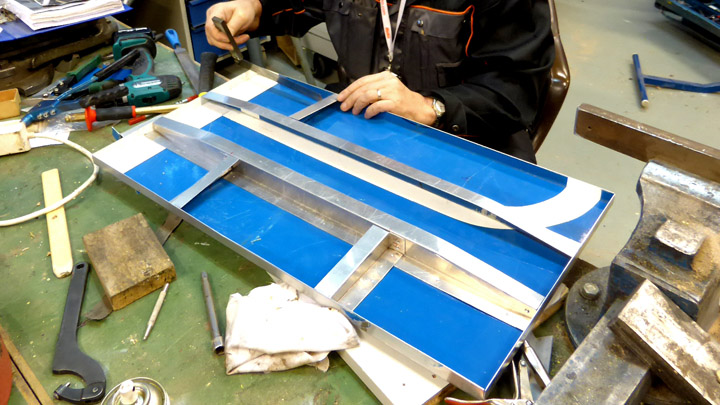 The luggage-compartment is made up of a canvas bag with an aluminium bottom-plate. The blank for the bottom-plate was cut according to the original drawings. The edges of the blank were bent and the outside bottom stiffeners were cut and fastened to it using pop-rivets. The outside of the bottom-plate was painted grey. This also nicely covered everything that had earlier been painted on the plate.
At the same time work on the canvas-bag was going on. First we were going through draper´s looking for a thick brown cloth that would be as like the original one as possible. Finally a suitable cloth was found and purchased. It was cut to measure and sawn to shape with doubled cloth to achieve the necessary stiffness. The bags opening was covered by a lid sawn from the same cloth. The top of the lid was sawn to the bag and the rest of the lid fastened to the edges of the bag using original like latches.
The flexible canvas-bag is fastened to the fuselages tube-structure using leather straps with buckles. Suitable straps were readily available in a shop. The straps were run through leather fasteners riveted to the corners of the bag.
Now the luggage-compartment canvas bag could be fastened to the aluminium bottom-plate. This was done by riveting the bottom edges of the canvas bag to the bended sides of the bottom-plate.
The finished luggage-compartment was installed into the fuselage-frame behind the cock-pit. First the bottom-plate was to the vertical frame tubes using the fabricated lugs and then the canvas-bag was tied to the frame using the leather belts. Now the brand new luggage-compartment was ready to be used by the pilots – made by the Tuesday Club. But I think it want be flying anywhere!
When needed for our restoration projects, we have received aluminium plate, both new and used from Finnair technical department. They have also given us written off tools– that have proven themselves most useful for our purposes. We bow deeply and thank Finnair for its valuable support of our efforts to preserve the Finnish Aviation Heritage. |
|
Avainsanat: aviation history, restoring, old aircraft, Valmet Vihuri, VH-25 |
MY-14's tail repairs, part eightPerjantai 10.2.2017 - Reino Myllymäki The chains and cables for rudder, elevator and aileron trims of MY-14 were lacking except some very rusty chain pieces. So, the chains and cabled had to be manufactured acoording to the designs and original parts.
The used chain proved original material since the stamp was same than in orginal parts. The wire clips were original material used in the State Aircraft Factory but not exactly same.
The feed-throughs were existed but abrasion covers were lacking. They were made from "lusto" according to the designs. "Lusto" is an old polymere, nitrocellulose, called also to Parkesine.
The bearing bracket of the rudder trim and the traction wheel of the elevator trim were in the restorable condition. They were disassembled and repaired. The aluminium wire coils were lacking and the new ones were made by lathing. All parts were assemled and the entity was tested. It is working! |
|
Avainsanat: aviation history, restoring, old aircraft, VL Myrsky II, MY-14 |
Wing of Kurki to Tuesday ClubLauantai 4.2.2017 - Member of Tuesday Club Since the spring 2016 the Tuesday-Club has been doing conservation work on Kurki Fuselage. Until now it has not been possible to start work on its wings, stored at the Päijät-Tavastia Aviation Museum in Vesivehmaa, because the other ongoing projects have taken up so much space in the workshop at the Finnish Aviation Museum.
However, now that the Kurki fuselage has been moved to the museums hall for changing exhibitions, there is enough space in the workshop for the Kurki wing. Well, not for the whole wing, but for one of the halves. Compared to the size of the Kurki, the wing is rather big – with a total span of 12.3 m (including the width of the fuselage) each wing is 5.75 m long and 2.32 m wide – quite a kite!
On January 24th, the Kurki fuselage was moved to the changing exhibitions hall, were conservation/restoration work on it is continuing. At the moment work on the aluminium engine installation cover-plates is ongoing. The top one is fixed but the side-covers can be opened to allow access to the engine mount area. The covers are made of 1,2 mm thick aluminium-plate.
On Monday January 30th, a Defence Forces interchangeable-platform lorry performed a conscript driver’s special-transport training mission. Coming from Tikkakoski it arrived at the Vesivehmaa airfield where it unloaded its enclosed platform to the ground in front of the back doors of the museum hangar at Vesivehmaa. The right wing of the Kurki was loaded and securely tied-down into the enclosed platform. It was a close fit. The enclosed platform was lifted back onto the lorry and the trip to Vantaa could begin.
After a couple of hours the precious cargo was at the door of the restoration workshop at the Finnish Aviation Museum at Vantaa and the wing was moved into the workshop. Mission completed – with benefits for all parties – the War Museum (owner of the Kurki), the aviation museums and the Defence Forces. Many thanks to all parties taking part in this operation.
Both halves of the wing have been damaged, both mechanically and by rot during their 90 years in storage. The Kurki was stricken off the books and put into storage in 1927. There are about 30 holes of different sizes in the plywood surfaces of the right wing. In places the plywood has rotted to a degree requiring its replacement.
However, the wing is in better condition than the upper wings of the I.V.L. D. 26 Haukka I. But plenty of hard work and elbow-grease will be needed before the work is done. We can begin the actual work after finishing the “current condition check” and the thorough cleaning of the surfaces. The cleaning has already begun. |
|
Avainsanat: aviation history, restoring, old aircraft, IVL K.1 Kurki |
Work on the exhausts of MY-14 ongoingSunnuntai 29.1.2017 - Member of Tuesday Club The original engine planned to be used on the VL Myrsky was the British Bristol Taurus. Because of WW II this did not happen. Instead, the American Pratt & Whitney R-1830 two-row radial engine was selected, almost the same version as on the Douglas DC-3. Myrskyn MY-14 - entisöintiprojektia varten on käytössämme DC-3 koneessa ollut Twin Wasp -moottori. Koska moottori on ollut DC-3 koneessa, se ei ilman muutoksia sovi Myrskyyn asennetavaksi. Yksi merkittävä muutoksen kohde koskee moottorin pakoputkia.
The Twin Wasp with the exhaust collector of DC-3 in left picture and the Twin Wasp of VL Myrsky II with oval pipes in right picture. On the DC-3´s Twin Wasp the exhausts from each cylinder is connected to a single exhaust gas collector from which there is a single exit pipe. On the Myrsky a different solution was implemented – The exhaust from each cylinder was gathered to be expelled through five oval exhaust pipes on top of each other on both sides of the engine under the NACA cowling ending at the back-part of the cowling. At the end of each 10 round exhaust pipes 200 mm long, tapered nozzles were welded. At the weld the nozzles had a diameter of 60 mm but they were tapered towards their end, ending as a 28mm X 60 mm rectangles. A smaller final cross-section was used to increase the speed of the exhaust gases and thus creating some added thrust.
The exhaust system that is to be built during the restauration will be a copy of the original one. At the moment the single pipes from each cylinder, forming a veritable “snake-pit” are being formed into shape by a partner contractor at Samet Oy. The nozzles are being made by the Tuesday-Club.
They are being made from 28 rectangular parts cut out from sheet-metal. To form them into the requires shape the club made the necessary male and female mould parts used to shape the flat sheet-metal parts In a hydraulic press.
After being pressed the edges to be welded were cleaned and chamfered for welding. The assembly, welding and fitting of the exhaust-system to the Twin-Wasp engine will be done by Patria Oyj. |
|
Avainsanat: aviation history, restoring, old aircraft, VL Myrsky II, MY-14 |
Oxygen system for MY-14Perjantai 27.1.2017 - Reino Myllymäki The oxygen bottles, controls, taps and meters of MY-9 and MY-14 were disappeared but the brackets, adapters, the remains of the oxygen pipes as well as the plate of the pressure and flow meters and controls were remaining. The original oxygen pipes were broken off and therefore they were useless.
The oxygen bottles were found from the Hallinportti Aviation Museum and they have been in VL Myrsky fighter according to the imprints of fastening bands. The other parts of the oxygen system were found from the storages of the museums. Therefore it was possible to assemble the proper oxygen system of VL Myrsky fighter for MY-14 from original parts. Only the oxygen pipes had to be renewed.
The best brackets were chosen in order to be restored. The steel and aluminium bands were blasted by glass balls and the bolts were renewed. The abrasion covers of the fastening bands were renewed. According to the design documents they should be made from leather. However, the imprints on the bottles showed that they were made from canvas fabric. Therefore canvas was used in the restoration.
The bottles and the parts of the oxygen system were cleanded and covered by Renaissance wax. The pipes were made from new copper pipe and the fastening screws were renewed. Othewise the system was assembled from original parts. The normal solder paste was used in the solder joints instead of a hard solder.
The fastening band of the rubber oxygen tube was taken from the MY-9. It was straightened, basted by glass balls, painted by Isotrol stripping laquer and paint finish. A padding made from leather was fastened inside of the band. Photos: Finnish Air Force Museum. |
|
Avainsanat: aviation history, restoring, old aircraft, VL Myrsky II, MY-14 |
MY-14 got voltage regulatorKeskiviikko 25.1.2017 - Reino Myllymäki VL Myrsky II had a Russian voltage regulator located at the right corner in the front of the cockipit. However, the regulator of the MY-14 has disappeared. The brackets remained but they were corroded and bent. The sprung rubbers were destroyed and the filling sleeves were disappeared.
A proper voltage regulator (RKK GS 1000) was fortunately found from the storages of the Finnis Air Force Museum. It was cleanded outside and inside and covered by Renaissance vax.
The brackets were fixed, blasted by glass balls and painted. The bolts and sprung rubbers were renewed and the used rubbers were probably from MiG fighters. They seems to be copied from Britishs ones. Needed filling sleeves have been made from duraluminium by lathe work. Photos: Finnish Air Force Museum. |
|
Avainsanat: aviation history, restoring, old aircraft, VL Myrsky II, MY-14 |
The "Kurki" got it's spurTorstai 29.12.2016 - Member of Tuesday Club The I.V.L. K.1 Kurki fuselage brought for restauration/conservation by the Tuesday Club at Vantaa from the Päijänne-Tavastia Aviation Museum at Vesivehmaa was without its spur. And even more interesting was the fact that no sign of a spur having been installed could be found on the fuselage. This fact was strange, as a spoon-type spur can be seen on all historical photographs of the Kurki. Why was it now missing? Probably no final answer on this issue can be given, but we think we can provide an educated guess to this question.
Surviving photographs show, that the Kurki had a spur when it was flown using both a wheels and skies equipped undercarriage. But documents about the Kurki also tell us that it was finally also flown using floats. We presume that the spur and thereto related items inside the fuselage, useless on the float-version, were removed and the fuselage then partly re-covered.
In the end the Finnish Air Force was not interested in ordering the Kurki as a liaison-plane, and this led to an end of the development of the plane and to putting it in storage. And thus, it did not regain it’s removed spur. At some stage during it’s storage the floats were removed and replaced with skis, and like this it has been stored at Vesivehmaa since the late 1940ies. The skis are probably not the original ones belonging to the Kurki, but still typical 1920ies skis as produced by the Air Force Aircraft Factory.
As the Kurki is now on skis, it was decided to refit the missing spur. No drawings of the Kurki have survived, so to remake the spur we had a good look-see at available photographs of the Kurki. Based on them, we assumed that the shaft of the spur was wooden and the rest of it of metal construction. The wooden shaft was supported by a metal-tube support from behind and it was presumably fastened to the fuselage using a metal-plate. The shape of the metal spoon-part of the spur can be seen in the pictures. Based on this we could make the necessary work-drawings for the spur and start making it.
We started by making the wooden shaft of the spur. Then we fabricated the sheet-metal part with associated sleeve for fitting the wooden shaft and to fasten the assembly to the fuselage. For the spoon side of the shaft we made another metal-sleeve with which the shaft and the spoon are fastened to each other. Finally we welded the spoon from purpose cut metal parts. The spur-spoon and supporting metal tube assembly was painted using black Isotrol-varnish and the wooden shaft and metal fastening plate at the fuselage were painted silver.
The Kurki fuselage did not show any signs of how the spur had been originally fitted to the under-surface of the fuselage. We ended up bolting both sides of the upper metal plate of the spur assembly through the wooden bottom longerons running each side of the fuselage using inside metal supports to which the bolts had been welded atop the longerons.
Luckily, the fabric-covering on the bottom fuselage had been put in place using string-fastening, so it could be easily opened to install the needed metal-parts inside the fuselage. When the plates with associated bolts had been installed, whit the bolts going out through the holes in the longerons and the outside metal sleeve it was time to torque the nuts and the job was done. The result looks very much like the spur on the photographs of the original Kurki. |
|
Avainsanat: aviation history, restoring, old aircraft, IVL Kurki |


